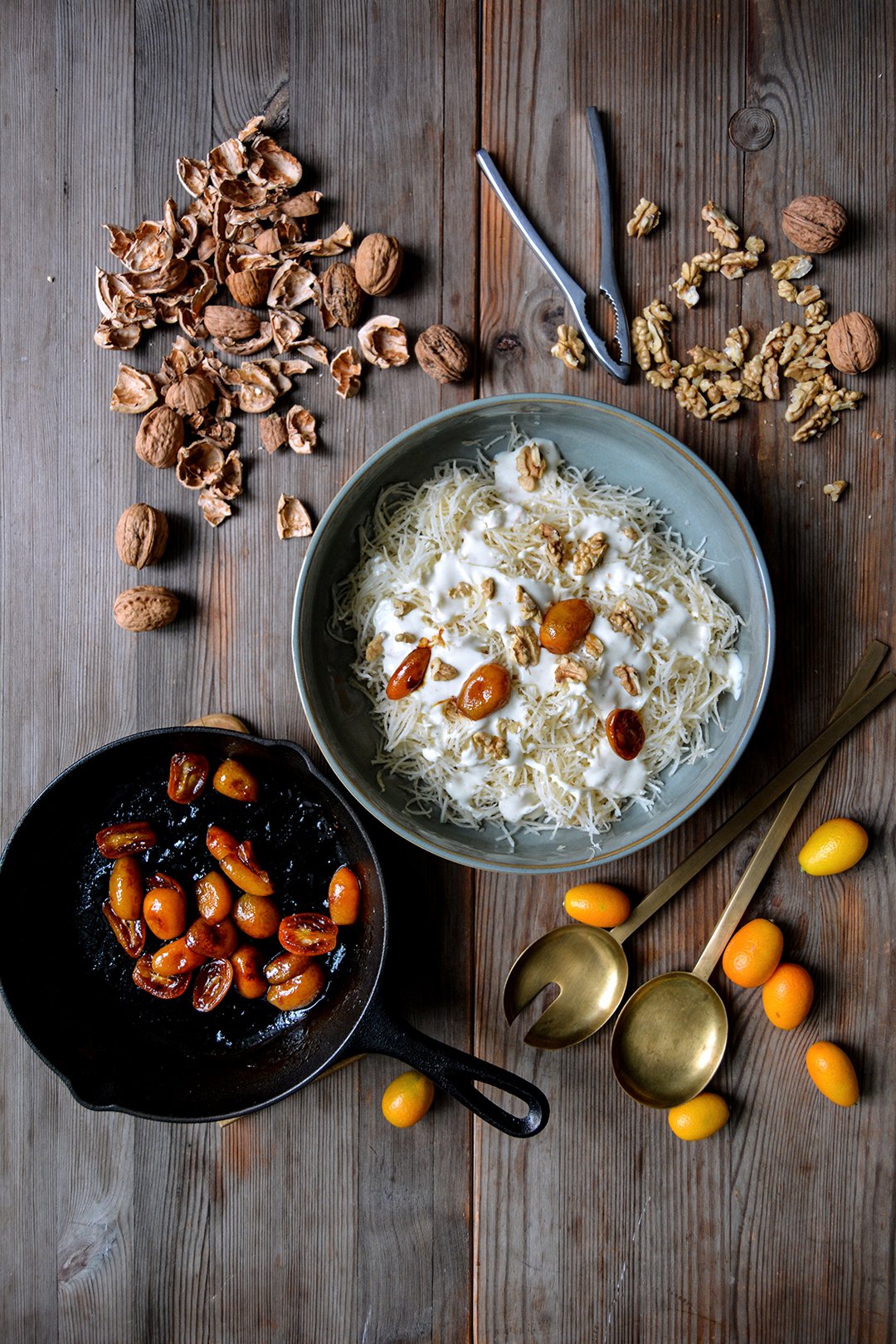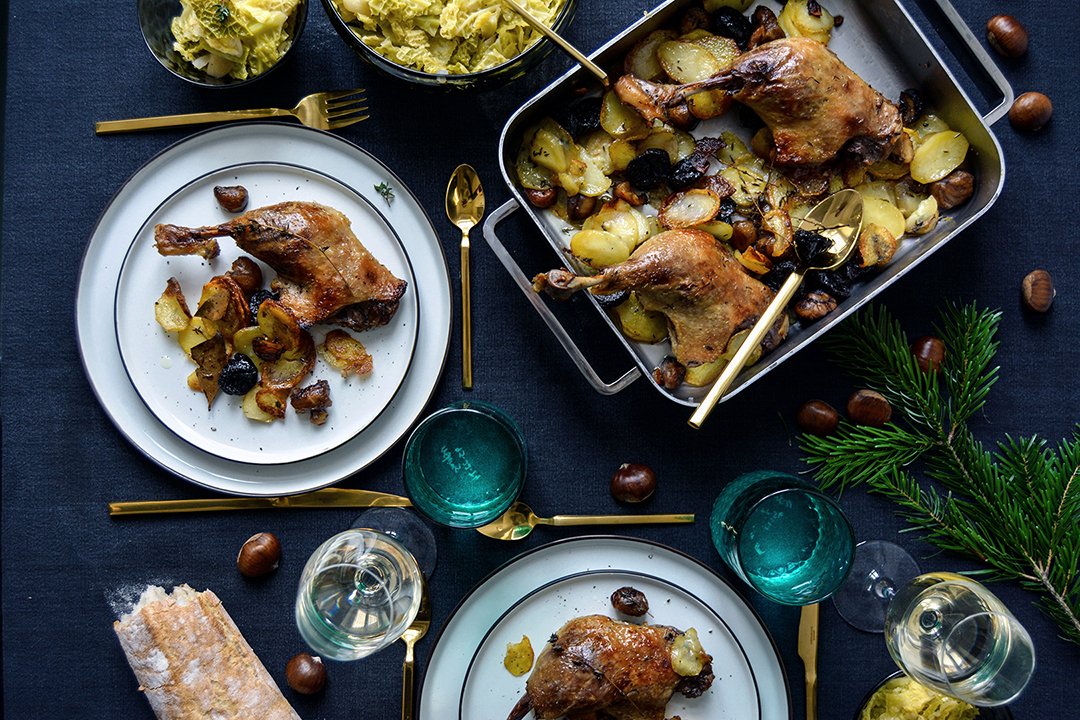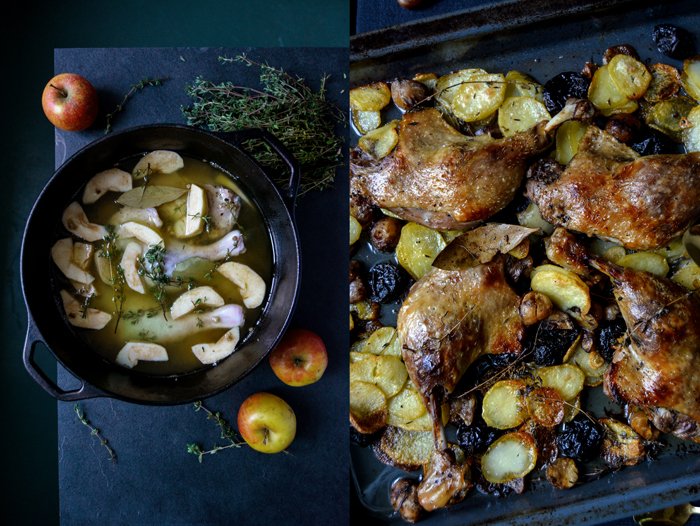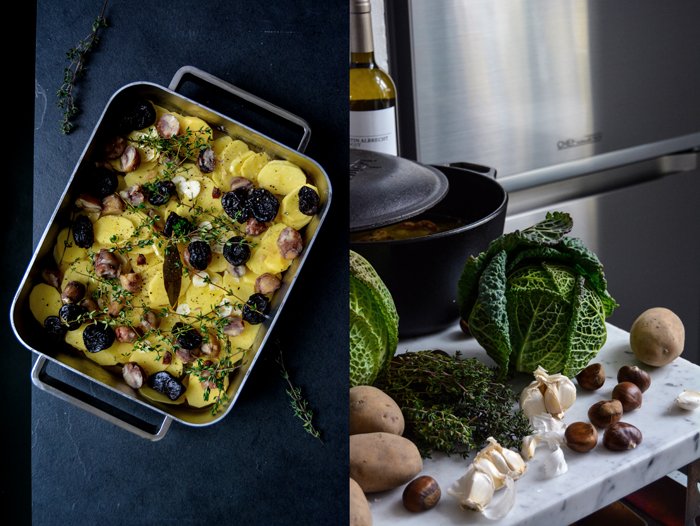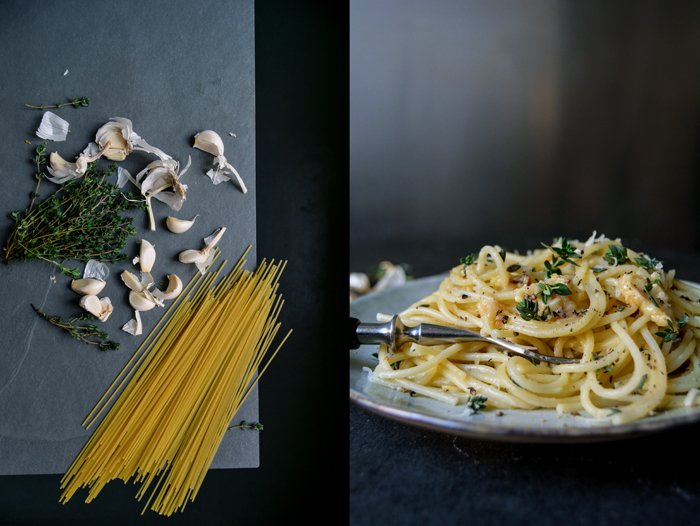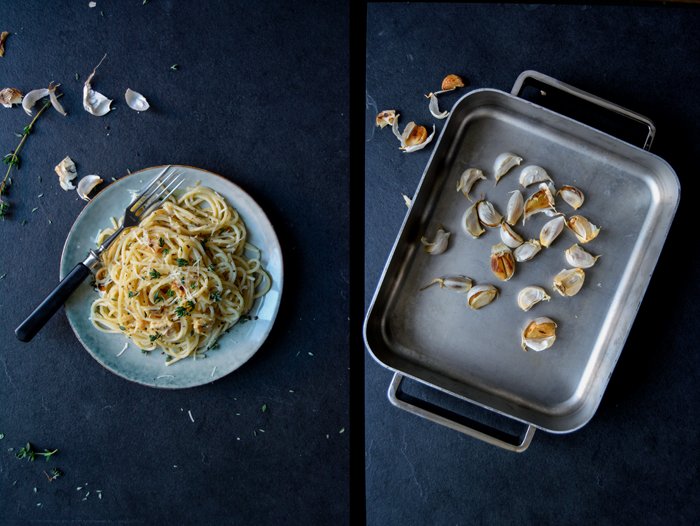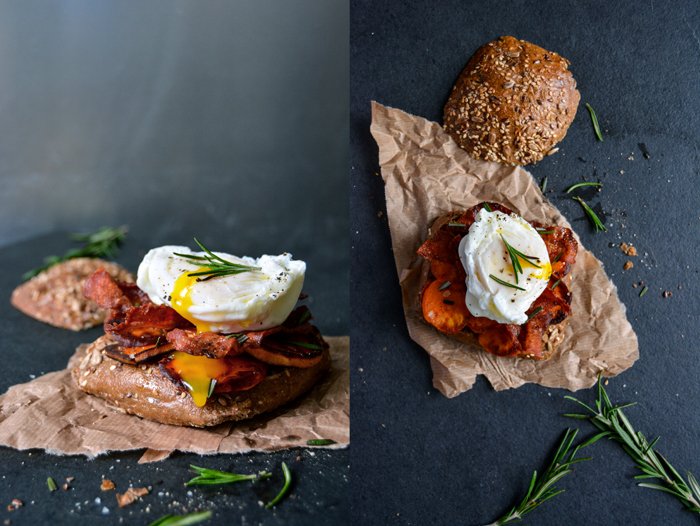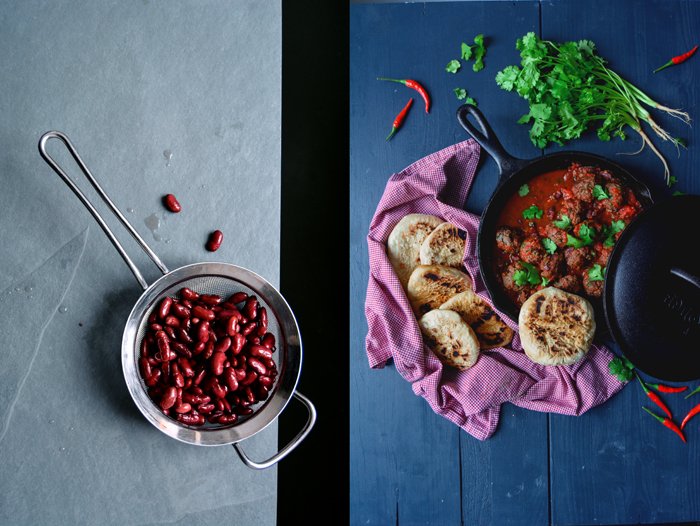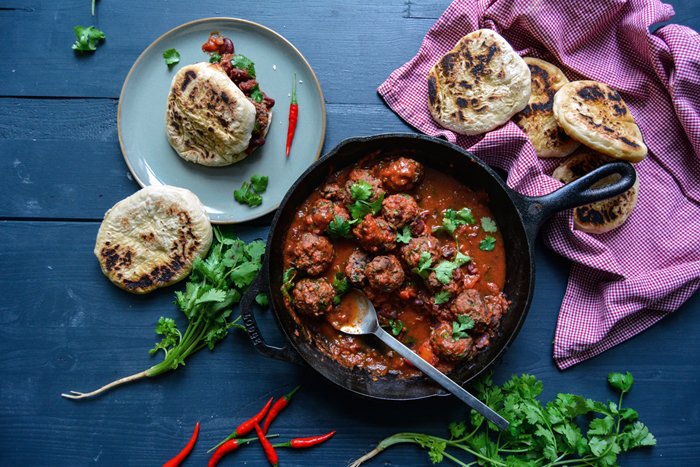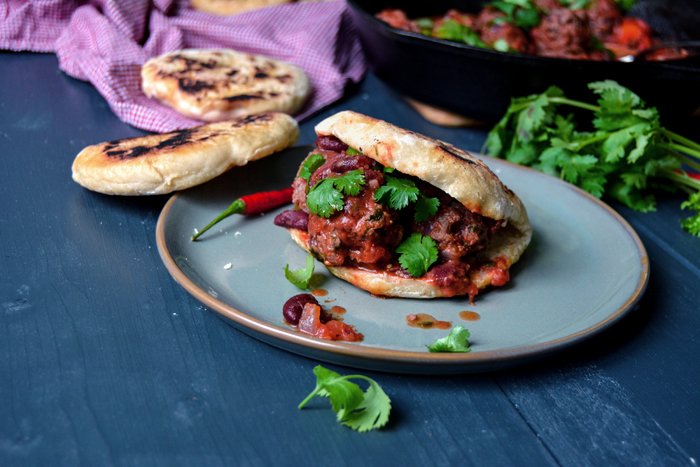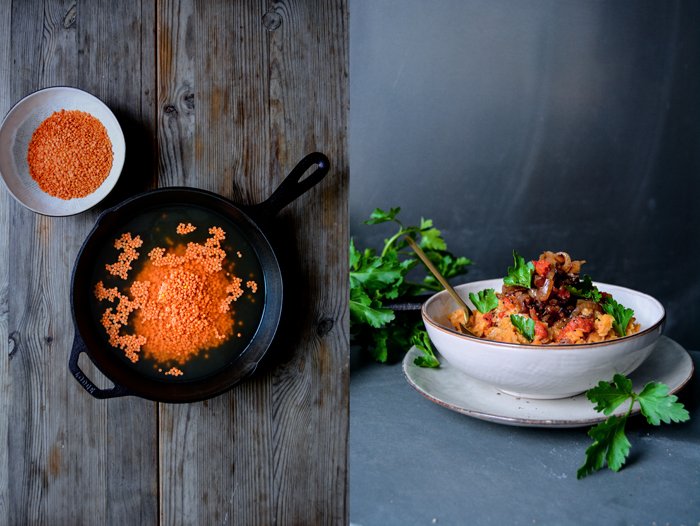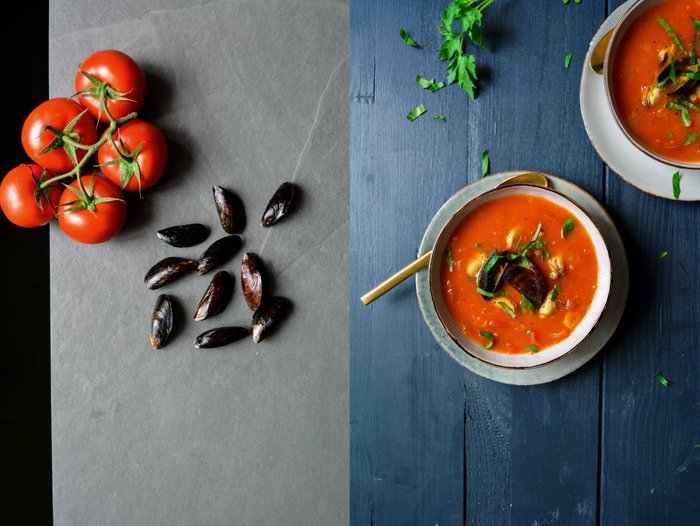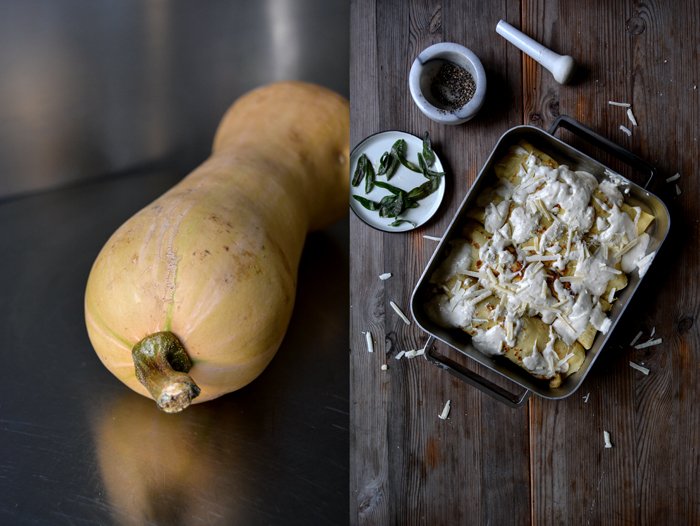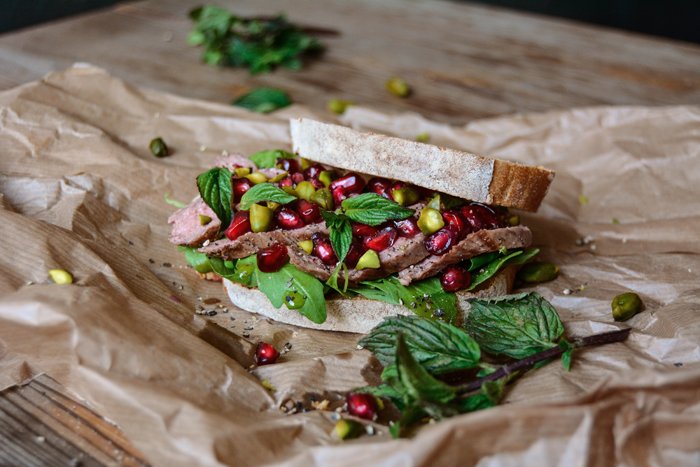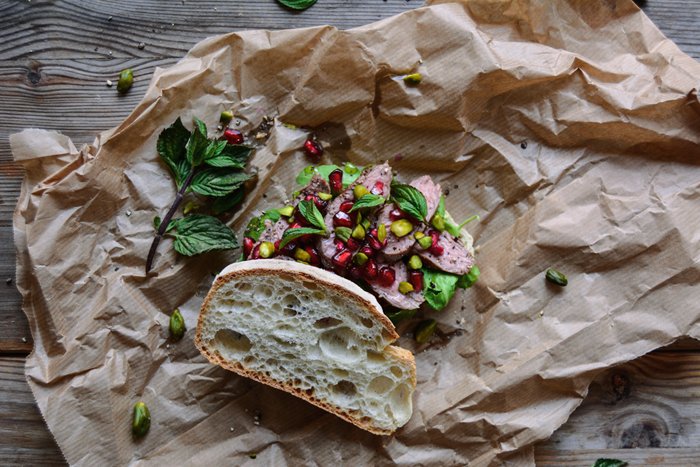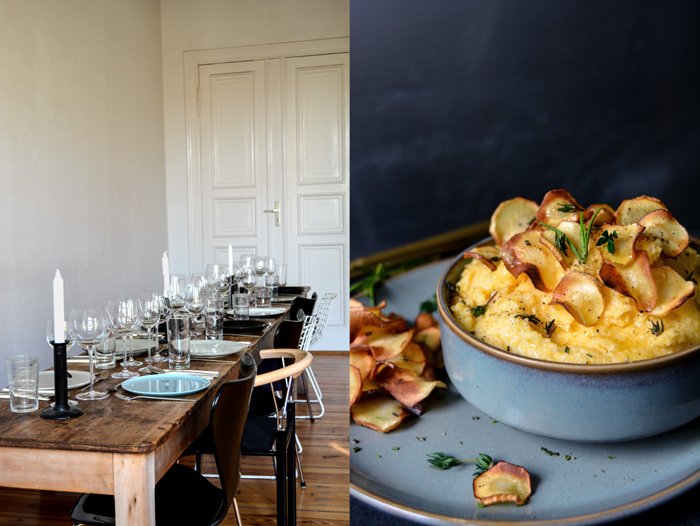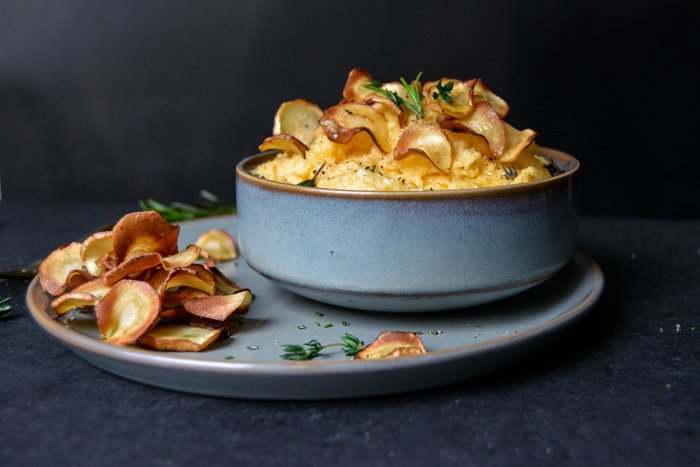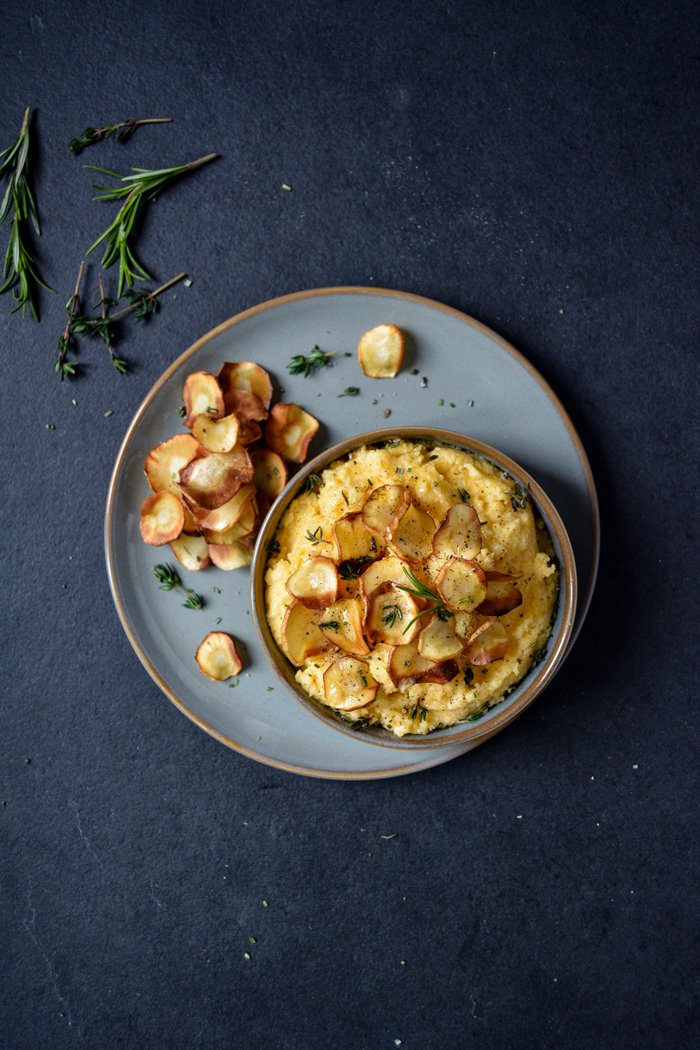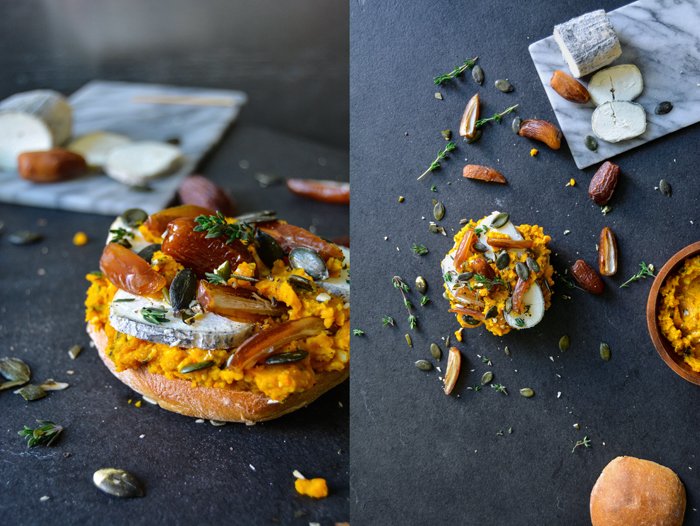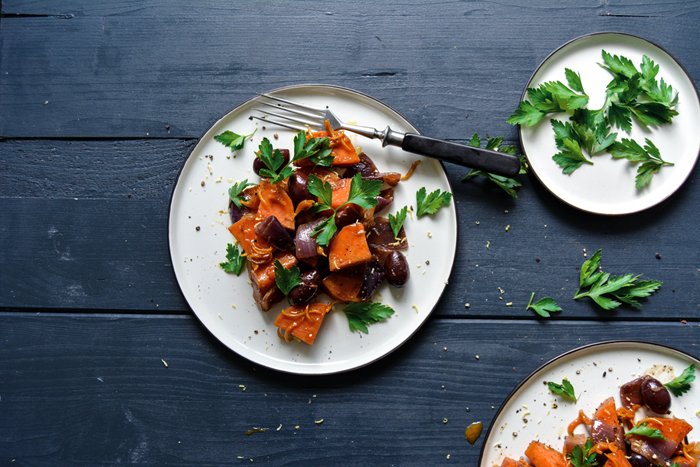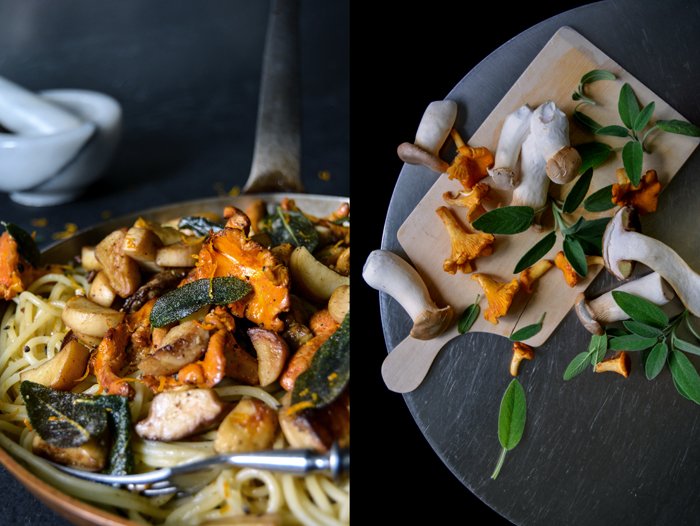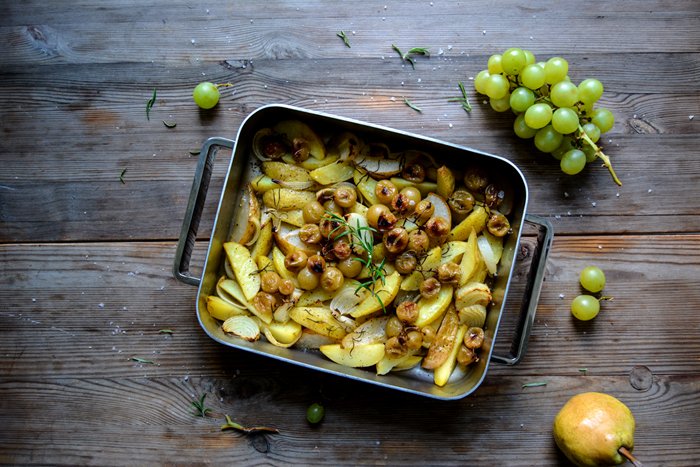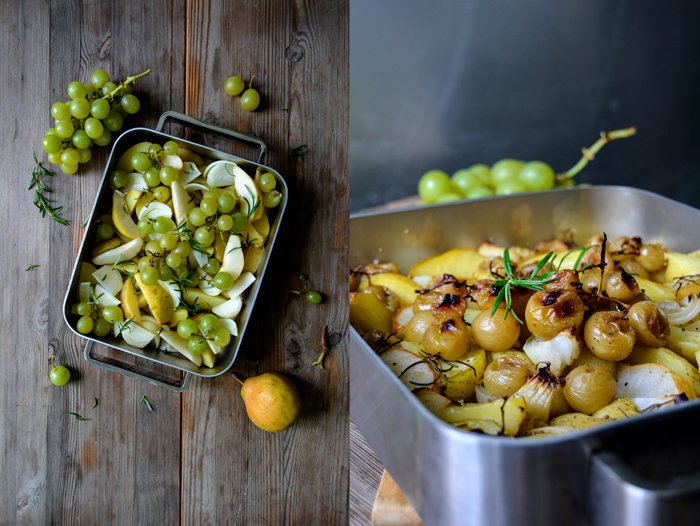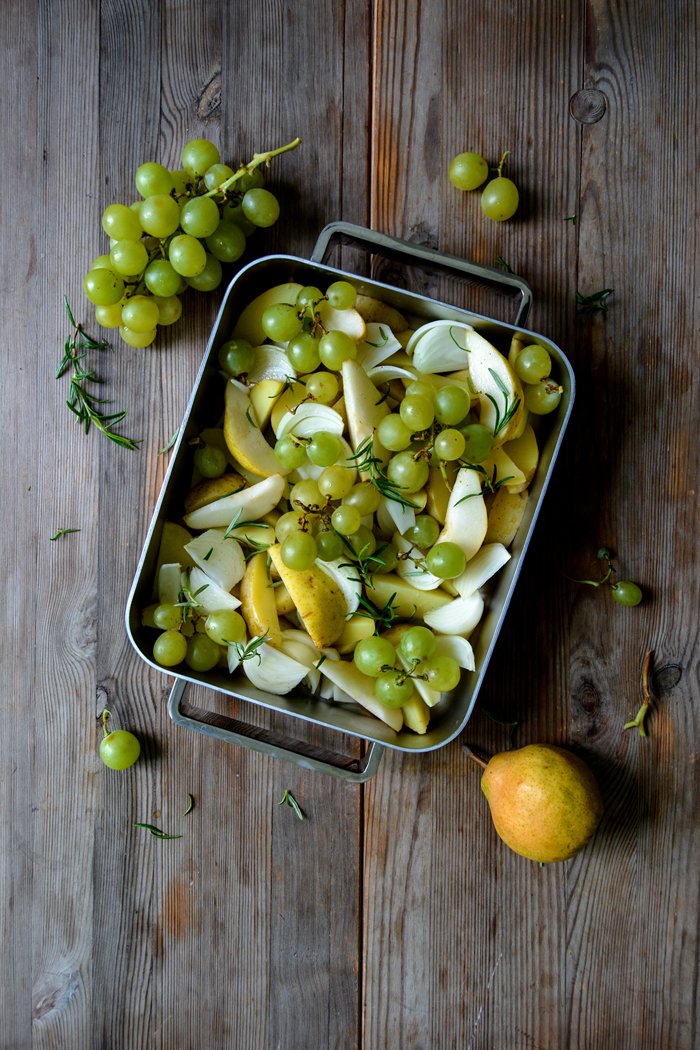meet in your kitchen | Capri, Lobster & Pasta e Patata at Hotel de Rome in Berlin
I always had a weak spot for grand hotels. It must have been my mother who planted this seed in the early days of my life. We used to travel a lot together, to Europe's old cities, Mediterranean getaways and snowy villages in the mountains. And wherever we went, we fell for the splendid charm, beautiful architecture and culinary excitement of a luxurious hotel - we're girls after all. Be it for a few nights, or just a cappuccino or glass of wine at the bar, these places tend to take us into another world as soon as we walk through the revolving door.
In Berlin, you can find one of these magical houses at a beautiful piazza framed by the imposing buildings of the Humboldt University and the Berlin State Opera, right on one of the city's most prominent boulevards - Unter den Linden. Walking into Rocco Forte's Hotel de Rome reveals a house full of elegance and history. The former Dresdner Bank Headquarter was built in 1889, thick stone walls, marbled columns, gold leaf mosaics, and Berlin's prettiest ballroom covered by a huge skylight, are symbols of an era of grandeur. The bank managers' former offices have been turned into chic suites, and in the basement, where the hotel's spa is located in our days, you can still see the rooms secured by heavy iron doors where the bank once held its gold deposits. Its a piece of the city's history, preserved and turned into a place to relax, enjoy and savour. My personal highlight is the spacious roof terrace overlooking the city, it's one of Berlin's best locations to enjoy a sundowner on a warm summer's night. I can't wait for them to come back.
The Hotel de Rome combines two cultures - Germany and Italy - and especially in the kitchen, the Mediterranean side took over. The legendary Tuscan Michelin-stared chef Fulvio Pierangelini, Director of Food responsible for the honest approach to Italian cuisine in a few hotels of the Rocco Forte family, has a fantastic team here in Berlin. Jörg Behrend, Executive Chef, and his Sous-Chef Davide Mazzarella create such delicious treats at the La Banca Restaurant that I decided to meet them in their kitchen. On an icy-cold and snowy morning, I walked into the hotel's bar in desperate need of a warming tea. After a chat with the Bar Supervisor, Jörg Wischner, I found out that the choice wouldn't be easy. He offered me a selection of 40 delicate leaf compositions, which you can also enjoy at a traditional afternoon tea ceremony at the hotel's cosy Opera Court, inspired by their London sister, the Brown's Hotel. While I was sipping on a fragrant golden green tea, he explained the extensive cocktail menu, which made me wish I had come in the evening. But I was here to cook and learn about Capri's cuisine.
Davide's family used to have a renowned restaurant on Italy's little island in the Gulf of Naples, when Capri was still the place to be for Europe's high society and American movie stars. He says those days are over, but the traditional recipes he learned to cook from his family, the time spent with them in the kitchen, peeling potatoes and chopping vegetables, made the young man want to become a chef and take his home's scrumptious food out into the world. Jörg Behrend is from western Germany but he feels strongly inspired by Italy's culinary treasures. Through traveling and working with his Italian-German team for many years, he has almost become Italian himself. So it didn't take long for us to decide what we'd like to cook together: Pasta e Patata all Astice. It's a Capri classic that was completely new to me, thinly sliced potatoes and spaghetti cooked like a risotto and topped with a lobster. The everyday basic version is made without seafood, which isn't necessary, but it turns it into an extravagant treat. Pasta e Patata is often served as one of many courses during a special family lunch.
Needless to say, the meal was perfect, it's one of the secrets of Italian cooking, you don't need many ingredients to create something outstanding. I find it even better than risotto. To make our Italian lunch complete, we enjoyed it with crisp white wine at a big table together with the Hotel de Rome family. This is how it feels at this hotel, it's a family taking care of you. Thank you Jörg, Davide, Türkan, Sebastian, and Jörg (at the bar) for a bit of Capri in Berlin!
Pasta e Patata all Astice
Serves 4
olive oil
garlic, crushed, 1 clove
onions, peeled, 220g / 8 ounces
red chili pepper, seeded and thinly sliced, 1/4 - 1/2
waxy potatoes, peeled, quartered, and cut into 1/2cm / 1/4" slices, 500g / 17 1/2 ounces
vegetable broth, about 1 1/2l / 6 1/4 cups, plus more as needed
dried spaghetti spezzati (broken into 6cm / 2 1/2" pieces) 400g / 14 ounces
cherry tomatoes, cut into quarters, 10
Parmesan, freshly grated, 180g / 6 1/2 ounces
fresh basil, a handful, torn into pieces
fine sea saltground pepper
lobster, cooked, removed from its shell, 2 (each about 500g / 17 1/2 ounces)
butter 1 tablespoon
a few thyme leaves
In a large, wide pot, heat a generous splash of olive oil over medium heat and sauté the garlic, onions, chili, and potatoes for a few minutes until the onions are golden and soft. Cook like a risotto, add a little vegetable broth to cover the potatoes, let the potatoes soak the liquid, and add a little more when it's all soaked, stirring occasionally. Repeat until the texture is velvety thick and the potatoes are almost soft. Add the spaghetti and more broth and let the spaghetti cook, stirring, until al dente. Add more broth as necessary. In the last few minutes, let the dish thicken like a risotto. Stir in the tomatoes, Parmesan, basil (leave out a few leaves for the topping), and season to taste with salt and pepper. Cover and let sit for a few minutes.
While the potatoes are cooking, prepare the lobster: In a medium, heavy pan, heat the butter and thyme over medium heat, add the cooked lobster, and cook until golden.
Divide the pasta e patata among plates, lay the lobster on top, and sprinkle with fresh basil leaves.
Buon Appetito!
Jörg, you are Chef de Cuisine at Rocco Forte'sHotel de Rome and the La BancaRestaurant where the kitchen is run by a German-Italian team: Sous-Chef Davide Mazzarella is from Capri and Fulvio Pierangelini, Director of Food and founder of the famous – but now closed - Gambero Rosso in Tuscany, was born in Rome. Did this experience make you a little Italian? How important are different cultural backgrounds in the kitchen?
Jörg Behrend: My Italian side grew considerably through working in our team. To understand the philosophy, the easiness, and the purism of the Italian cuisine, it's important to have this constant exchange with my Italian colleagues. It helps to create delicious dishes.
Davide, you worked in Michelin-starred restaurants in Italy, the L'Olivo in Capri and Davide Scabin's Combal. Zero in Rivoli, before you decided to work abroad. What are the differences between working as a chef in restaurants in Italy and in Germany?
Davide Mazzarella: I don't think that the differences between Italy and Germany are that big. It's important to work professionally, in both places. There is a difference regarding the availability of ingredients and products, it's much easier to get them in Italy. Always fresh and seasonal, it's possible to buy whatever you need twice a day. In Germany you have to trust your suppliers and hope that they bring you what you need.
Jörg, you are from Limburg, a picturesque town in the west of Germany. Does your home region's cuisine come through in your work sometimes?
Jörg Behrend: Unfortunately not, my home's cooking is quite rich and rustic. There are also a few popular combinations that might be hard to understand if you're not a local, like potato soup with plum cake.
Davide, you grew up in Capri where your family ran a renowned restaurant for decades. How did this restaurant influence your life? How did Capri change over the years?
Davide Mazzarella: I learned the kitchen basics in our family restaurant and I have to thank my grandmother and parents that I'm a chef today. They inspired me and they passed their passion for this job on to me. Capri is beautiful, and famous, but it had its glorious days between the 50's and late 70's. In the past 20 years, the island became too touristy and, with time, we lost many traditions.
How important is the food and the cuisine that we grow up with as children for our adult life?
Jörg Behrend: The cooking of our childhood is essential and a guidance for the rest of our life. Looking back, I'm very thankful for my mother, giving us fresh, homegrown vegetables, freshly squeezed juices from the fruit from our own trees. The meat and cold cuts we ate came from butchers and farmers, where the animals were treated well. My grandmother was the queen of preserving. Be it sauerkraut or raspberry jam, all year round, she was busy preserving fruits and vegetables. It came with age, that I understood how - unknowingly - conscious my mother used to cook. This is a guideline for me and my wife, which we're trying to hand down to our own kids, and to show them the recipes from our childhood.
Davide Mazzarella: It's everything. What we eat as a child and what we like is saved as a memory for the rest of our life. The smell is also important. The smell of tomato sauce still excites me as it did then, when I lived at home.
How did the German and the Italian cuisine change over the past 10-15 years?
Jörg Behrend: The old recipes were forgotten. Then Nouvelle Cuisine took over, followed by a renaissance of the Deutsche Küche (German Cuisine) with the most modern techniques. Today, we cook regional, seasonal, and sustainable. We use the most simple products to create culinary highlights. We also use the entire animal again, rather than single parts. Back to the roots.
Davide Mazzarella: After the Nouvelle Cuisine, and the Spanish cuisine - with Ferran Adrià and the Molecular Cuisine - the Italian cuisine found its way back to its roots. Many recipes from the 18th century have been re-discovered and newly interpreted, with new cooking techniques and methods.
How important is seasonal and local produce for your creations?
Jörg Behrend: The quality is important, if you can't find the right quality in your region, you have to search for it outside the regional borders. We use seasonal produce for our creations.
Davide Mazzarella: It's very important. To work with seasonal and local produce is a MUST in our days. I love it, when our suppliers bring the produce from small producers from the countryside to our kitchen, it makes cooking more fun.
How do you develop new recipes? Where do you find inspiration?
Jörg Behrend: There's a growing influence through social media, and through travels to Italy, looking for original recipes.
Davide Mazzarella: Tradition, experience, personal technique, and knowledge. Inspiration comes naturally, and sometimes you have to take a peek at what others do.
Who has been your biggest inspiration in the kitchen? Who or what inspired you to start a career in food?
Jörg Behrend: Friends of my parents owned a hotel with a very good restaurant. I used to work there during my summer holidays and I was fascinated by the kitchen processes and the dishes they created. They offered me an apprenticeship and I gladly excepted.
Davide Mazzarella: My family, but especially my grandmother and my mama.
What was the first dish you cooked or baked on your own, what is your first cooking memory?
Jörg Behrend: My earliest memory is the smell of fresh jus in the cooling room. I can never forget about it. Unfortunately, I don't remember my first dish.
Davide Mazzarella: I think it must have been spaghetti aglio e olio. It was disgusting. And I can never get the smell of O' Rau’ (Neapolitan Sunday and holiday dish) out of my head.
What are your favourite places to buy and enjoy food in Berlin?
Jörg Behrend: Restaurant Grünfisch in the Gräfekiez, the farmers' market at Karl-August Platz in Charlottenburg, Frischeparadies on Morsestrasse, Cafe Set´s on Schlüterstrasse, Küstlichkeiten in the Markthalle Neun.
Davide Mazzarella: Vitaminchen at Oliver Platz, Frischeparadies on Morsestrasse, Masaniello Pizzeria on Hasenheide.
If you could choose one person to cook a meal for you, who and what would it be?
Jörg Behrend: Beef stew, together with my mother.
Davide Mazzarella: Neapolitan Salsiccia wrapped in fig leaves and cooked in ashes, together with my father.
You're going to have ten friends over for a spontaneous dinner, what will be on the table?
Jörg Behrend: Everything that I can find in the fridge, and everybody should bring something to the table.
Davide Mazzarella: There will definitely be something on the table, I just don't know what yet.
What was your childhood's culinary favourite and what is it now?
Jörg Behrend: Spinach, potatoes and egg in my childhood. Salt-baked fish with artichokes and a salad of bitter lettuce leaves whenever I can get it. Or pasta sugo in all its variations.
Davide Mazzarella: Riso e lenticchie (rice and lentils) in my childhood. Today: spaghetti aglio e olio my way.
At home, do you prefer to cook on your own or together with others?
Jörg Behrend: At home, I let my wife cook. When we have guests, everybody is involved.
Davide Mazzarella: I don't like cooking at home. And if I did cook, it would have to be for a beautiful woman.
Which meals do you prefer when you cook privately, improvised or planned?
Jörg Behrend: Improvised.
Davide Mazzarella: Improvised.
Which meal would you never cook again?
Jörg Behrend: Snails. I had to cook them during my apprenticeship.
Davide Mazzarella: Once I got a sturgeon, alive. It's an experience I don't need ever again.
Thank you, Jörg and Davide!
Turkish Pide with Provençal Olive Tapenade
Anatolia - my new favourite cookbook by Somer Sivrioglu and David Dale - inspired me to create a cultural fusion. Turkey and France meet in my vegetarian version of Somer's Lahmacun - thin pide (Turkish pizza) spread with a thin layer of minced meat and chopped vegetables. The original recipe uses minced lamb and tastes fantastic, but when I enjoyed this crisp treat a couple weeks ago, I decided to try a meat-less variation of it.
Compared to Italian pizza, it's a quick project. The dough is made without yeast and doesn't need to rise, and the ingredients for the tapenade pulsed in a blender don't need much time and attention either. The topping is dark and concentrated, lots of Kalamata olives, parsley, red onion, capers, anchovies, and mustard. It's quite an addictive little snack, the two of us ate all four pide in one go at lunchtime!
Pide with Provençal Olive Tapenade
Serves 2-4
For the dough
plain flour 270g / 2 cups plus 2 tablespoons
salt 1 teaspoon
water, lukewarm, 125ml / 1 cup
For the tapenade
pitted black olives, preferably Kalamata, 200 g / 7 ounces
flat- leaf parsley leaves 20g / 1 large handful, plus more for the topping
medium red onion, chopped, 1/2
capers, preferably preserved in salt, rinsed and dried, 25 g / 2 tablespoons
anchovy fillets, rinsed and dried, 4
olive oil 8 tablespoons, plus more for the topping
freshly squeezed lemon juice 2 tablespoons
Dijon mustard 2 teaspoons
ground pepper
For serving
Fresh red chili pepper, thinly sliced, 1/2
Preheat the oven to the highest setting (at least 260°C / 500°F) and put a baking sheet on the bottom of the oven.
For the dough, combine the flour and salt in a large bowl, add the water, and mix with the dough hooks of an electric mixer for a few minutes until well combined. Transfer the dough to a countertop and continue kneading and punching it down with your hands for 5 minutes until you have a smooth and elastic ball of dough. Divide the dough into 4 balls, place them back in the bowl, cover with a damp tea towel, and leave to rest while you prepare the tapenade.
Purée the ingredients for the tapenade in a blender or food processor until smooth.
On a floured table or countertop, roll out the dough with a rolling pin into four 23-cm / 9-inch rounds and cover with a tea towel. Transfer 1 round to a floured pizza peel (or medium cutting board) and spread evenly with 1/4 of the tapenade (you might need a bit less) and sprinkle with a little chili pepper. Transfer the pide to the hot baking sheet in the oven and bake for 4-5 minutes or until golden brown. Take the pide out of the oven, drizzle with a little olive oil, and sprinkle with a few parsley leaves. Repeat with the remaining pide. Enjoy warm or cold.
Celeriac Salad with Caramelized Honey Kumquats and Walnuts
Berlin, January 2016:
My little cookbook library got extended by a few amazing recipe collections. Santa was so kind to leave a few gems under the tree: Nigel Slater's new The Kitchen Diaries III, Jerusalem by Yotam Ottolenghi and Sami Tamimi (finally!), Vegetarian India by Madhur Jaffrey, and the fantastic Anatolia by Somer Sivrioglu and David Dale. The latter blew me away! This book is gorgeous, the pictures are mouthwatering and the dishes inspired me as soon as I laid my eyes on the first page. I'll definitely write about it again in the next few weeks, I already tried one of the recipes for a Turkish pizza and it was divine.
Madhur is a new find for me, I haven't had much time to thumb through the pages of her book but what I've seen so far looks divine. Nigel's book is a cooking bible with 250 (!) recipes - and I'm already struggling with the amount of work I have with the 100 recipes in my Eat in My Kitchen book! I love his approach to creating recipes, the way he writes about them and the beautiful photos taken by Jonathan Lovekin who's also been responsible for Nigel's former kitchen diaries, which I'm equally obsessed with. I'm sure I'll spend quite some time with this book in the next few years.
One of Nigel's creations, which is the 248th recipe in the book, struck me right away: a gorgeous celeriac and blood orange salad sprinkled with nigella seeds and capers. I haven't tried it yet - but I will soon - however, it made me think about celeriac salads. I like the addition of citrus, especially my beloved blood orange, but so far they haven't been in sight at the market. Kumquats came to mind, caramelized and softened in sizzling honey, I used these sweet, sour, and bitter bites for my luscious Orange Blossom, Ricotta, Kumquat, and Pistachio Tartine last April. It was quite a beauty. For my salad of grated celeriac, I also added a creamy yet light yoghurt-cardamom dressing, and sprinkled it with walnuts. Some honey drizzled on top to enhance the sweetness and my first winter salad of 2016 was born. Thank you Nigel!
If you're not that fond of kumquats, you can replace them with orange fillets.
Celeriac Salad with Cardamom-Yoghurt, Caramelized Honey Kumquats, and Walnuts
Serves 3-4
For the dressing
yoghurt 200g / 2/3 cup
olive oil 2 tablespoons
freshly squeezed orange juice 1 tablespoon
ground cardamom 1/4 teaspoon
freshly grated orange zest 1/2 teaspoon plus 1 teaspoon for the topping
fine sea salt
ground pepper
For the salad
peeled celeriac, grated, 250g / 9 ounces
freshly squeezed lemon juice 1 tablespoon
liquid honey 1 tablespoon plus 1-2 tablespoons for the topping
freshly squeezed orange juice 4 tablespoons
kumquats, cut in half lengthwise, 12 (or 12 orange fillets)
walnuts, 1 large handful
a few black peppercorns, crushed in a mortar
For the dressing, whisk together all the ingredients until smooth and season to taste with salt, pepper, cardamom and orange juice.
In a large bowl, mix the grated celeriac and lemon juice, using your fingers. Sprinkle with the dressing.
Heat 1 tablespoon of the honey in a small, heavy pan on high heat, add the kumquats and the orange juice and cook for about 2-4 minutes or until soft and caramelized, turn them once or twice and mind that they don't burn. Take the pan off the heat and arrange the kumquats on top of the salad.
Sprinkle the salad with walnuts, crushed pepper, and additional orange zest, and drizzle with honey. Enjoy immediately or let it sit for a few hours. It won't look as pretty anymore but tastes just as good.
Salt Baked Salmon Fillet with Dill, Black Pepper and Juniper
If you're still looking for a scrumptious but effortless main course for New Year's Eve and if you like salmon fillet, this is your recipe. After festive days of rich, meaty treats I prefer to start the new year with a lighter dish, seafood, lots of vegetables, or Asian inspired recipes, preferably easy dishes refined with colourful aromas, spices and herbs. Salmon baked in salt crust came to mind, but not a whole fish - I want to keep it simple - only the fillets, sandwiched with a handful of dill, crushed juniper berries and black pepper. Sealed under a mixture of coarse sea salt, flour, cornstarch, egg white and water, it bakes in the oven soaking up all these wonderful flavours. After 50 minutes it was done, which I checked by following Martha Stewart's tip: Insert a metal skewer, if it's warm to the touch, the fish is ready to leave its crusty shell. You have to use a sharp bread knife to cut open the salty crust, this is the only part of this recipe that demands a bit of work. You could also break it but I wanted to open it like a lid - only for visual reasons. The result is perfectly flaky, firm with a subtle hint of sea salt, it can be a bit overpowering on the edges of the fillet but you can easily scratch this excess salt off. I used fleshy fillets tied together with a cotton string, it was enough for 3-4 people - depending on the amount of dishes you're planning to serve. Two thick center pieces of roughly the same size are perfect, you could also fill them with other herbs or thin lemon or orange slices but I wanted to use the flavours which I use for my traditional gravad lax recipe: fresh dill, spicy pepper and fragrant juniper.
During the holidays, I cleaned the shelves in my kitchen, which were in a rather chaotic state, and to my surprise, I found far more packages of the Cini's sea salt than I had expected. They didn't last very long, I needed 1 kg / 2 1/4 pounds to cover my salmon. The Cini's salt comes from the Mediterranean Sea, from Gozo, where the family harvests the white crystals straight from the rocks. It tastes fantastic, it's obviously salty but not in a harsh way, it has a distinct flavour, which you can recognize in the cooked fish. I recommend using high-quality salt for this recipe, although you will discard the crust, it effects the final result tremendously.
A very exciting year has almost come to an end. I look forward to 2016 and I hope it will be more peaceful and united than the year before. My kitchen will be as busy as ever and I can't wait to share more recipes with you, here on the blog and in my first eat in my kitchen book, which will be published in September.
I wish you a wonderful start to the New Year, don't get intimidated by too many resolutions, just enjoy your life!
Meike xx
Salt Baked Salmon Fillet with Dill, Black Pepper and Juniper
Serves 3-4 (for more people you can use bigger fillets and leave them in the oven a little longer)
high-quality coarse sea salt 1 kg / 2 1/4 pounds
plain flour 100 g / 3 /4 cup
cornstarch 30 g / 1/4 cup
organic egg whites 2
water, cold, 75 ml / 1/3 cup
salmon fillet, 2 center pieces with skin (about 680 g / 1 1/2 pounds in total)
juniper berries, coarsely crushed in a mortar, 8
black peppercorns, crushed in a mortar, to taste
fresh dill, 1 small bunch plus 1 tablespoon chopped fresh dill, for the topping
Preheat the oven to 200°C / 400°F (conventional setting). Line a baking dish with parchment paper.
For the salt crust, combine the coarse sea salt, flour, cornstarch, egg whites, and water in a large bowl until combined, use your fingers or a spoon.
Spread a little of the salt mixture on the lined baking dish, lay 1 salmon fillet - skin side down - on top of the salt. Rub a little crushed pepper and half the juniper into the pink side of the salmon, then cover with the dill. Rub the second salmon fillet with pepper and the remaining juniper and lay it on top of the dill - skin side up. Tie the fillets together with a cotton string (see picture below), then cover the salmon with the remaining salt mixture until it's completely covered (see 2nd picture), push the salt mixture together gently. Bake in the oven for about 50 minutes or until a metal skewer, poked through the crust into the thickest part of the salmon, is warm to the touch when you pull it out of the salmon.
Let the crust cool for 1-2 minutes, then cut it open with a sharp bread knife. Cut the string open, divide the fish fillets in 3-4 portions, and serve immediately. Sprinkle with freshly chopped dill on the plates (optional).
Chickpea Potato Soup with Rucola Pesto, Lemon and Fried Chickpeas
A couple days ago, we left Berlin to visit the gardens of Sanssouci Palace a few miles outside Berlin. The palace used to be the Prussian king, Frederick the Great's summer residence, built in the 18th century. The building itself is beautiful but the terraced garden is stunning. I love being there in summer, when it's all lush, green and in bloom but there's a certain melancholic mood woven into the misty air on a cold, grey day that fits this time of the year perfectly. It's pure silence, no leaves left on the trees, the marble sculptures high up on their pedestals looking down on us, wrapped in jackets and scarves on our way to another one of the park's winter attractions, a Christmas market and its warming mulled wine.
When we got home I felt so frozen that I promised myself I'd make a rich soup the next day. I cooked canned chickpeas and potatoes in broth, puréed it into a velvety, smooth soup and sprinkled it with fresh rucola pesto, lemon zest and fried chickpeas. It's a great winter soup, thick and refreshing, and just right before tomorrow's feasting begins.
I wish you a wonderful and peaceful Christmas with your loved ones. Enjoy the moments of love, joy and good food! xx
Chickpea Potato Soup with Rucola Pesto, Lemon and Fried Chickpeas
You won't need all the pesto for the soup but I don't like making pesto in small batches. We used the remaining pesto to spread on toasted dark bread, which we enjoyed with the soup.
Serves 2-4
For the soup
olive oil
medium onion, chopped, 1
garlic, crushed, 2 large cloves
potatoes, peeled, cut into cubes, 250g / 9 ounces
canned chickpeas, rinsed and drained, 250g / 9 ounces, reserve 4 tablespoons for the topping
vegetable broth 900ml / 3 3/4 cups
bay leaf 1
salt
ground pepper
nutmeg, preferably freshly grated
ground cumin 1/8 teaspoon
For the pesto
rucola (arugula) leaves 60g / 2 ounces
Parmesan 25g / 1 ounce
pine nuts 25g / 1 ounce
olive oil 75 ml / 1/3 cup
salt 1/8 teaspoon
For the topping
freshly squeezed lemon juice
olive oil
lemon zest
black peppercorns, crushed in a mortar
For the soup, heat a splash of olive oil in a large pot and sauté the onion on medium-heat for a few minutes until golden and soft. Add the garlic and cook for 1 minute. Add the potatoes and chickpeas, stir and cook for 1 minute. Pour in the broth, add the bay leaf, and season with a little salt and pepper. Lower the heat and simmer, uncovered, for 20-25 minutes or until the potatoes are soft.
While the soup is cooking, purée the ingredients for the rucola pesto in a blender or food processor. Season to taste and set aside.
For the fried chickpeas, heat a splash of olive oil in a small, heavy pan on high heat. Add the reserved chickpeas, close with a lid immediately (the chickpeas will pop) and fry for 1 minute or until golden. Take the pan off the heat.
When the potatoes are soft, discard the bay leaf and purée the soup in a blender, food processor or with an immersion blender until smooth. Season with salt, pepper, nutmeg and cumin to taste, bring to the boil, and simmer for 1 minute, stirring constantly. Divide the soup between bowls, drizzle with a little lemon juice and olive oil and sprinkle with rucola pesto, lemon zest, crushed pepper and the fried chickpeas.
Christmas Duck Confit with Roast Potatoes, Chestnuts, Plums, and Star Anise
Berlin, December 2015:
It's only a week until Christmas and I'm starting to get excited! The culinary plan for the holidays isn't complete yet, there are still a few important questions to discuss, but flambéed Christmas Pudding for dessert and my obligatory slow roasted duck are already on the list. In the past 2 years of eat in my kitchen, I shared 2 Christmas recipes with you that feature a whole duck cooked for hours at very low temperature. This year, I decided you deserve a break - although I'll still put mine in the oven, early, on the 24th for Christmas Eve, at 85°C / 185°F, as always.
Recently, I had another one of my food phone calls with my mother, we spoke about confit de canard, duck legs cooked in the oven for hours in a dutch oven full of the bird's fat. The meat is succulent and meltingly tender and - conveniently - you can use the fat that it cooked in for months to fry potatoes and sear your meat. It's the best! I decided to have a little pre-holiday-celebration and cook a Christmas-y duck confit roasted on crispy potatoes refined with chestnuts, dried plums, and star anise. Although the duck legs don't need as long as my whole Christmas duck, you'll need about 1 1/2 days in advance for the preparation. First, you marinate the meat in salt and herbs for a few hours, or preferably overnight. The next day, you'll cook the legs in the oven in 1kg / 2 1/4 pounds of duck or goose fat (for 4 legs), I used goose fat as I forgot to place my order at the butcher in time but it works just as well. It takes about 2 1/2 hours before the meat almost falls off the bones - it's beautifully tender but pale at that point. Now, you can either keep the duck confit in the fridge until you'll need it - you could even store it for months as long as it's completely covered in fat (although I have never tried that). Instead, I would turn the oven on the next day, lay the legs on top of thinly sliced potatoes and roast everything for about 30 minutes (plus 20 minutes for the potatoes before you lay the meat on top). You use some of the tasty fat - that you'll have plenty of - to cook the duck and vegetables to crisp and golden brown perfection. During this time, I cooked a bowl full of apple Savoy cabbage, fresh and light without cream but with tender bite instead.
If you spread the preparation over 2 1/2 days it's quite an easy Christmas lunch - or dinner - that doesn't actually demand much work, just the right logistics. And if you're still looking for some really good wine for Christmas, we already made our choice: We'll enjoy Martin Albrecht's Gelber Muskateller (Muscat) and his 2012 Herbstnebel (Syrah, Cabernet-Sauvignon and Nebbiolo)! I wrote about his fantastic wine a couple months ago, click here to find out more about his old vineyards in the south of Germany.
Apart from this culinary pre-celebration, there was also a pre-Christmas gift that I got overly excited about: we have a new fridge in the house! In the past few months, while cooking and baking even more than usual due to my book, I often suffered from my old fridge's limitations and I knew that something had to change sooner or later. I did some research behind the silver doors of today's chic refrigerators, which all look quite similar from the outside. I remembered a tall model by Samsung that had caught my attention last year but at that point, my 12-year old fridge was still fully functioning and I was still forgiving regarding its limitations. So when Samsung had invited me to a presentation of their latest Chef Collection, a series of kitchen appliances developed together with Michelin-starred chefs, I wasn't ready for a change yet. But as soon as they offered me this huge, elegant silver fridge, after months of trying to fit in all the vegetables that I needed to cook and shoot for my book, I said "Yes, please!" I got it - thank you so much for that Samsung - and I'm totally happy about the fact that it keeps the temperature constantly stable and is especially energy saving - and I particularly enjoy the telescopic slide out drawer at the bottom, the Chef Zone. Maybe this is how some people feel about cars, but these little details are more than just practical, this is fun! But first and foremost, it's huge compared to our old fridge and I love it. There's so much space that I haven't even managed to fill it yet but I'm sure this will change next week, once the Christmas shopping begins.
Duck Confit with Potatoes, Chestnuts, Plums and Star Anise
Serves 4
For the duck confit
coarse sea salt 1 1/2 tablespoons
black peppercorns, crushed in a mortar, 1 1/2 teaspoons
duck legs 4
fresh thyme 1 small bunch
duck or goose fat (jarred, or fresh uncooked goose fat from your butcher, cleaned from skins and veins, finely chopped) about 1 kg / 2 1/4 pounds
firm, sour apple, peeled, cored and sliced, 1
bay leaves 2
For the roast duck legs and potatoes
medium, waxy potatoes, peeled and very thinly sliced, 8
pre-cooked chestnuts 200g / 7 ounces
dried plums 150g / 5 ounces
garlic, thinly sliced, 3 cloves
star anise 3 pods
a small handful fresh thyme sprigs
fat used to cook the duck, about 180ml / 3/4 cup
coarse sea salt
black peppercorns, crushed in a mortar
For the apple Savoy cabbage
fat used to cook the duck 3 tablespoons
medium onion, finely chopped, 1
a small head of Savoy cabbage, cut into quarters, cored, roughly chopped, rinsed and slightly wet, about 500g /17 1/2 ounces
firm, sour apple, peeled, cored and roughly chopped, 1
dry white wine about, 300ml / 1 1/4 cups
nutmeg, preferably freshly grated
fine sea salt
ground pepper
Day 1
For the duck confit, combine the salt and pepper. Lay the duck legs in a baking dish, rub the skin with the salt-pepper mix and lay half the thyme under the meat and the other half on top. Cover with plastic wrap and keep in the fridge for a few hours, preferably overnight.
Day 2
Set the oven to 120°C / 250°F (conventional setting). Rub the salt off the duck legs with a paper towel, reserve the thyme sprigs.
Melt the (jarred) duck or goose fat in a large dutch oven over medium heat. If you use fresh goose fat from your butcher, let the cleaned and chopped fat cook over medium-high heat for 1 1/2 minutes or until the fat is melted. Take the dutch oven off the heat and let the fat cool for 2 minutes. Add the duck legs, the reserved thyme sprigs, the apple slices and bay leaves, everything should be covered in fat. Place the pot, uncovered, in the oven and cook for 2 1/2 hours. Take the dutch oven out of the oven and continue roasting the legs or cover the dutch oven and roast the legs the next day.
Once the duck legs are roasted you can pour the remaining fat in a sterilized jar and keep it in the fridge for months. It's great for fried potatoes, roasts and cabbages.
Day 3
Set the oven to 220°C / 425°F (conventional setting).
Spread the potatoes in a large baking sheet (don't use a small baking dish like in the picture below, I had to transfer them to a bigger sheet after 10 minutes as they were too moist). Add the chestnuts, plums, garlic, star anise, thyme, and fat, season with salt and pepper, and toss to combine with your fingers. Roast for 10 minutes, stir, and roast for another 10 minutes. Take the duck legs out of the fat - if the fat is hard place the dutch oven over medium heat to soften it - and lay them on top of the potatoes, skin side up. Roast in the oven for 25-30 minutes, stirring the potatoes every 10 minutes, or until crisp and golden brown.
While the potatoes are roasting, cook the cabbage: In a large pot, heat the fat over medium-high heat. Add the onion and cook for a few minutes until soft and golden. Add the cabbage and apple, stir, and cover. Lower the heat to medium and cook for 1 minute. Add the wine, nutmeg, salt and pepper and cook for 10-15 minutes or until the cabbage is just tender. Season to taste.
Arrange the duck legs and the potatoes on plates, serve with the cabbage filled in little bowls.
Roasted Garlic Butter Spaghetti with Thyme
The amount of garlic in this velvety, buttery pasta recipe sounds intimidating but if you let go of the idea of harsh, raw garlic and think of smooth, almost perfumed, oven-roasted cloves instead, it makes a lot of sense.
I used 22 large cloves, cooked in their skins in a hot oven. This kind of roasting turns them into a sweet, almost caramelized paste, so soft that you can mash them with a fork. I only mixed them with a bit of butter and salt and my pasta dish was almost done. Just young pecorino melted on top of the spaghetti - Parmesan would have been too strong and salty - and a few fresh thyme leaves and crushed peppercorns to balance out the sweetness.
It's a simple dish but there's something very sensuous and satisfying about it at the same time. If I weren't such a traditionalist, I could even consider exchanging my annual Christmas duck with this plate of pasta. A bottle of extravagant Bordeaux - bought without looking at the price, seeing that the dish itself wouldn't cost much - and my relaxed Christmas Eve would be sorted. However, I can't live without my slow roasted bird on the 24th December - which is Christmas in Germany. It was just a thought.
Roast Garlic Butter Spaghetti with Thyme
Serves 2
garlic 22 large cloves (in their skin)
spaghetti 200g / 7 ounces
butter, soft, about 30g / 2 tablespoons
flaky sea salt
young pecorino, freshly grated, about 2-3 tablespoons
fresh thyme leaves, about 2 tablespoons
black peppercorns, crushed in a mortar
Preheat the oven to 220°C / 425°F (conventional setting).
Spread the garlic in a large baking dish and roast in the oven for about 25 minutes or until soft. Turn the cloves occasionally and mind that they don't burn. Let them cool for a few minutes, peel them out of their skins and transfer them to a blender or food processor.
Cook the pasta in a large pot in plenty of salted water until al dente.
Add the butter and a little salt to the garlic in the blender and purée until smooth. Season with salt to taste.
Mix the warm spaghetti with the garlic butter and divide between plates. Sprinkle with pecorino, thyme, and pepper. Season with salt to taste and enjoy!
Sweet Potato, Bacon and Poached Egg Sandwich
At the moment I'm living, literally, next to a tree - our absolutely beautiful Christmas tree. It's perfect this year. Lush and green, the branches thick and densely packed with needles, the straight tip rising close to the high ceiling of our living room. I'm in love with this tree. I decorated it straight after it entered our flat Saturday evening and we clinked mugs full of hot mulled wine to celebrate its arrival immediately. I moved my working space to the dining table, which is right opposite this beauty, and I have problems keeping my eyes on the screen of my laptop. In December, I feel like a distracted little child, all this glitter and sparkling, Christmas ornaments and cookie boxes - how are you supposed to keep your mind focused on anything else?
However, there was something that caught my attention: a wintery sandwich lusciously stuffed with fried sweet potatoes - not as crisp as normal potatoes but they make up for it with sweetness and flavour - salty bacon, poached egg and a little chopped rosemary made it complete. The composition is so hearty that I went for a dark bun sprinkled with linseed, sunflower and sesame seeds. It's a keeper.
Sweet Potato, Bacon and Poached Egg Sandwich
Makes 2 sandwiches
olive oil
sweet potato, peeled and thinly sliced (less than 1/2cm / 1/4"-thick), about 200g / 7 ounces
fine sea salt
pepper, crushed in a mortar
bacon 3 slices
organic eggs 2
whole wheat buns, cut in half, 2
fresh rosemary needles, chopped, a small handful
In a large, heavy pan, heat a splash of olive oil and fry the raw sweet potato slices on medium-high heat for a few minutes on both sides until golden brown and soft. Season with salt and pepper to taste.
Heat a little olive oil in a heavy pan and cook the bacon on medium-high heat for a few minutes until golden brown and crisp, set the pan with the bacon aside.
For the poached eggs, bring a medium saucepan of salted water to a boil and reduce the heat to a low simmer. Crack 1 egg into a small bowl. Hold a large spoon just over the surface of the simmering water and gently pour the egg onto the spoon. Lower the spoon into the water and hold for 3 minutes—use a second spoon to put the egg back into place if it slips. Lift up the spoon, let the excess water drip off, and carefully place the egg on a plate—you may have to gently scoop it off the spoon. Poach the remaining egg the same way, adjusting the heat as needed to maintain a low simmer. It’s best to poach 1 egg at a time, but you can cook 2 at once. Once the first egg cooks on the spoon for 1 1/2 minutes, let it float in the water— mind that it doesn’t stick to the bottom of the pan—and poach the second egg on a spoon. Take both eggs out once they’ve cooked for 3 minutes each.
Brush the bottom bun with the frying juices from the bacon, spread a few sweet potato slices on it and lay half the bacon on top. Finish it off with a poached egg, chopped rosemary and crushed pepper. Season with salt to taste (if necessary) and enjoy.
Kidney Bean, Cumin, and Beef Polpette with Torta al Testo
I decided to fly to London for one day to meet a girl for a kitchen feature whose work I've been following for quite a while: Claire Ptak of the acclaimed Violet bakery. But then I started thinking about all the other inspiring people I know who also live there, so I felt tempted to meet a few more people for even more meet in your kitchen features. In the end, I met 1 baker from California, 2 kitchen chefs at the Brown's Hotel, 1 Vogue journalist, 2 bloggers, a friend from the fashion industry plus my publisher's team in London - all in 3 days. Now I'm back home, a little tired, but with fantastic, new kitchen features in my pocket and I can't wait to share them with you over the next few weeks.
There was a lot to organize before my departure to make my tight schedule work, so I couldn't spend much time on cooking, which my boyfriend happily used to take over our kitchen for a few days. One of his delicious and experimental creations was cumin polpette in a fruity tomato sauce. He used mashed kidney beans for the beef mixture, instead of the usual breadcrumbs and eggs, and kept some of the purple beans whole for the sauce. The texture of the floury legumes is perfect to loosen up the minced meat, the result is simply delicious. It was so good that we had it twice in a week, the second time with torta al testo on the side, Umbrian flatbread cooked in a cast iron pan, to stuff with the juicy cumin bean polpette and the aromatic red sauce.
Kidney Bean, Cumin, and Beef Polpette with Torta al Testo
You can find my torta al testo recipe here or you can serve the polpette with any other flatbread or ciabatta. If you want to make your own torta al testo, mind that the yeast dough has to rise twice. Once it's well risen, the bread only needs to cook for about 3 minutes in a hot pan.
Serves 2
minced beef 400g / 14 ounces
kidney beans (tinned), rinsed and drained, 250g / 9 ounces
medium red onion, finely chopped, 1
garlic, crushed, 2 large cloves
medium fresh red chili, cut into tiny cubes, 1
fresh coriander leaves 2 large handfuls
ground cumin
fine sea salt
ground pepper
olive oil
tomatoes (tinned), 400g / 14 ounces
pinch of sugar
Using your hands or the dough hooks of an electric mixer, mix the minced meat with a handful of the beans (squeezed until mushy), 3/4 of the onion, garlic, 1/4 of the chili, a large handful of coriander leaves (not chopped), 1 teaspoon cumin, 1 1/4 teaspoons of salt and a generous amount of ground pepper in a large bowl until well combined. Wet your hands and form 4cm / 1 1/2" meatballs, transfer the polpette to a plate.
Chop a small handful of the remaining coriander leaves and set a few whole leaves for the topping aside.
Heat a generous splash of olive oil in a large, heavy pan and cook the polpette with the remaining onions on medium-high heat for a few minutes until just light brown on all sides. Take out the meatballs and add the remaining beans (whole) to the hot pan, cook for 1 minute on high heat, stirring constantly. Add the tomatoes, chopped coriander leaves, 1/4 teaspoon of cumin, sugar, salt, pepper and 1/4 of the chili. Chop the tomatoes finely and transfer the polpette back to the pan. Stir gently, close with a lid and simmer for about 3 minutes on medium-low heat.
Season the sauce to taste and sprinkle with the remaining coriander leaves and chili. Serve the meatballs with torta al testo (or flatbread) on the side or inside the bread.
Spicy Harissa Lentils with Lemon Tahini and Sweet Onions
A friend of ours gave us a large bottle of tahini which he brought back to Berlin from his latest trip to Israel. Guy knows how much we love this oily sesame paste and it wasn't the first time that he brought some for us from one of his trips to the Middle East. This time, he announced solemnly that this Blue Dove Tahina is the best tahini ever. Unfortunately, I can't read anything that's written on it, apart from Quality Since 1921, the rest is in Arabic and Hebrew, but Guy told me that it's not actually from Israel but from Palestine. If only people could forget about borders as easily as food does when it travels.
So, our special Tahina deserved some special recipes. Hummus came first, enjoyed only with some soft chunks of a white loaf of bread dipped into the velvety creaminess. We sprinkled a few pieces of the bread with the pure tahini paste and agreed that it's so good that it doesn't really need any addition, pure on bread - that's perfection! However I couldn't stop myself from coming up with another delicious way of making use of it: I whisked together a thick, oily sauce made of tahini, garlic roasted in olive oil and lemon juice - it's divine. Then, I cooked red lentils in my homemade vegetable broth and mixed it with spicy harissa, I drizzled the tahini sauce all over it and finished it off with onions, cooked until they were juicy, golden brown and almost as sweet as candy.
This recipe has been featured by Food52!
Spicy Harissa Lentils with Tahini and Sweet Onions
Serves 2
For the lentils
red lentils 200g / 7 ounces
vegetable broth (unsalted) 1/2l / 2 cups plus 1 tablespoon
harissa
fine sea salt
ground pepper
olive oil 1 tablespoon
For the topping
olive oil
onions, cut in half and thinly sliced, 2
a pinch of sugar
black peppercorns, crushed in a mortar
fresh parsley leaves 12
For the tahini sauce
olive oil 3 tablespoons
garlic, cut into tiny cubes, 2 large cloves
tahini 1 1/2 tablespoons
freshly squeezed lemon juice 1-2 teaspoons
a pinch of fine sea salt
In a large heavy pan, bring the lentils and broth to a boil and simmer on medium heat for about 8 minutes or until the lentils are al dente. Stir in 1 teaspoon of harissa and 1 tablespoon of olive oil, season with salt and pepper.
While the lentils are cooking, heat a splash of olive oil in a heavy pan and cook the onions on medium heat for a few minutes until golden brown and soft, stir in a pinch of sugar.
For the tahini sauce, heat the olive oil and garlic in a small saucepan and cook on medium heat for about 1 minute or until the garlic is golden but not dark. Take the saucepan off the heat and pour the garlic oil into a bowl. Whisk in the tahini, 1 teaspoon of lemon juice and salt, season to taste.
Divide the lentils between plates, sprinkle with the tahini sauce, a little more harissa (optional), crushed pepper and parsley. Enjoy!
Saffron & Mussel Tomato Soup
It's getting colder here in Berlin, all of the trees in front of our windows are finally naked, their last colourful leaves swept away in a single stormy night. Before the winds came, the light in our living room was golden and warm, filtered through autumn's pretty yellow linden leaves. Now that they're gone, the light is much harder. All of a sudden, the city seems a bit more harsh, which made me long for a cozy soup.
Seafood has been on my mind for weeks, sweet mussels from the North Sea, adding their fine taste to a thick, fruity tomato soup refined with aromatic saffron. It warms the body and caresses the soul, what else could you want on a cold and misty November day? This dish may seem elaborate but that's not at all the case, it's a quick one. The fruit's red juices only cook for a bit longer than 10 minutes and the mussels sink into a fragrant broth of white wine and spices for just 5 minutes. I use the wine, infused with a soft hint of the sea and the noble taste of saffron, to stir into my glowing soup. It's supposed to serve 3-4, which I still believe is quite realistic, but we loved it so much that we almost emptied the large pot of soup in one go at lunchtime. We were hungry.
Saffron and Mussel Tomato Soup
Serves 3-4
For the mussels
mussels in shells 1 kg / 2 1/4 pounds
olive oil
medium onion, finely chopped, 1
garlic, thinly sliced, 2
large cloves
white wine 200ml / 3/4 cup plus 2 tablespoons
bay leaves 2
saffron threads 1/8 teaspoon / 1g
sea salt 1/2 teaspoon
ground pepper
For the tomato soup
olive oil
tomatoes, finely chopped, 1 kg / 2 1/4 pounds
garlic, thinly sliced, 1 big clove
broth, used to cook the mussels, 400ml / 1 2/3 cups
a pinch of sugar
sea salt
ground pepper
For the topping
fresh parsley, roughly chopped, 4 heaping teaspoons
Rinse and scrub the mussels under cold water and cut off the beard, discard any broken mussels.
For the mussels, heat a splash of olive oil in a large pot and cook the onion and garlic on medium heat for a few minutes or until golden and soft. Add the wine, bay leaves, saffron, salt and pepper, stir and bring to the boil. Turn the heat down to low, gently add the mussels to the pot, shake the pot or stir with a slotted ladle and close with a lid. Cook for 5 minutes or until the shells open, shake the pot once or twice while cooking. Take the mussels out with a slotted ladle, discard any mussels that don’t open. Measure 400ml of the mussel broth, together with the onions and the bay leaves, and set aside. Peel the mussels out of their shells, leave about 6-8 inside the shells for the topping of the soup (optional). Set the mussels aside.
Heat a splash of olive oil in a large pot, add the tomatoes and garlic and cook for 4 minutes on medium-high heat (open), stir once in a while. Add the mussel broth with the onions and bay leaves, sugar, salt and pepper and cook for about 7 minutes (open) or until the tomatoes are soft and the soup is thick. Season to taste and, if necessary, chop the tomatoes with a knife if they are too chunky, or purée the soup in a food processor. Stir in the mussel meat, divide the soup between bowls, sprinkle with fresh parsley and pepper and garnish with the mussels in their shells.
Pumpkin Crespelle with Ricotta and Sage
Around Halloween, my boyfriend feels the call of his American roots and carves scary faces in pumpkins. Being a good girlfriend I know my duties, so I went out into the world - or rather my local shop around the corner - to find only the finest examples for him. I brought quite a pretty collection back home and let him do his work but I ended up with far more squash in my kitchen than we needed. We had a vast selection, a few Hokkaidos in different shapes and sizes and butternut, which isn't really helpful due to its shape but I forgot in my enthusiasm. So it was obvious, pumpkin had to be on the menu!
Thin, golden Italian crespelle have been on my mind for weeks but my inspiration was missing, I had no idea what to fill them with. Halloween's squash became my muse and here it is: roasted pumpkin cubes paired with a little ricotta, the obligatory creamy Béchamel sauce, Parmesan and crisp, fried sage leaves. It looked and tasted so good that my sister Nina, who's in Berlin at the moment for a quick visit, almost bit my laptop screen when she saw the pictures. We ate it all, so unfortunately, there was nothing left for her.
Pumpkin Crespelle with Ricotta and Sage
Makes 4 crespelle
For the filling
mixed pumpkin (squash), cut into 1 1/2cm / 1/2" cubes, 550g / 1 1/4 pounds (like Hokkaido (with skin), or peeled butternut and musquée de provence)
olive oil
flaky sea salt
butter 2 tablespoons
fresh, large sage leaves 30
fresh ricotta 4 heaping tablespoons
Parmesan, grated, 70g / 2 1/2 ounces
black peppercorns, crushed in a mortar
For the Béchamel sauce
milk 600ml / 2 1/2 cups
bay leaf 1
a pinch of nutmeg, freshly grated
fine sea salt
ground pepper
butter 30g / 2 tablespoons
plain flour 30g / 4 tablespoons
For the crespelle
milk 160ml / 2/3 cups
organic eggs 2
plain flour 130g / 1 cup
fine sea salt 1/4 teaspoon
butter, to cook the crespelle
Preheat the oven to 200°C / 390°F (conventional oven) and line a baking dish with baking paper.
Spread the pumpkin in the lined baking dish, coat with 2 tablespoons of olive oil, sprinkle with flaky sea salt and cook in the oven for about 25 minutes or until soft. Take the pumpkin out of the oven and set aside, keep the oven set to 200°C / 390°F.
For the Béchamel sauce, bring the milk with the bay leaf, nutmeg, salt and pepper to the boil, take it off the heat once boiled. In a saucepan, melt the butter and whisk in the flour, let it cook on medium heat for 1 minute. Take off the heat and slowly add the hot milk, whisk until smooth and cook for about 3 minutes on lowest heat until it’s thick and creamy. Discard the bay leaf, season to taste and set the pan aside.
Mix the ingredients for the crespelle with an electric mixer until well combined and let the dough rest for about 5-10 minutes. Heat a little butter in a large, heavy or non-stick pan and cook 4 large, very thin crespelle on medium heat until golden on both sides.
Heat 2 tablespoons of butter in a saucepan on high heat and roast the sage leaves for a few seconds in the sizzling butter until golden and crisp but not dark.
Lay each crespelle flat on a plate, spread with 1/4 of the pumpkin and sprinkle each of them with 2 1/2 tablespoons of Béchamel sauce, 1 heaped tablespoon of ricotta, 3 sage leaves, some Parmesan and crushed pepper. Roll into a tight wrap and place them next to each other in a baking dish. Pour the remaining sauce on top and sprinkle with Parmesan. Bake for 12 minutes or until golden brown, switch on the grill (broiler) for the last 1-2 minutes.
A juicy Lamb, Pomegranate and Pistachio Halloween Sandwich
This has been the longest sandwich break ever since I started my Sandwich Wednesdays almost 2 years ago - and I missed them badly. There's something deeply satisfying about creating a sandwich, taking the pictures of this luscious dish - and especially - eating it! It's back again and although it was supposed to be a Halloween sandwich I must admit that it didn't really work out. I expected my creation to look a bit messier, wildly dripping with red (pomegranate) juices, but it turned into a pretty sandwich beauty instead. Never mind.
Anyway, the flavours count more than the looks and they are more than promising in this recipe. A bit more than a year ago I shared my juicy lamb sandwich with preserved lemons and capers with you, it was a much loved and often featured sandwich that called for a new interpretation. Seared lamb fillet only needs a little salt and pepper to become the most tempting piece of meat you can possibly have on your plate, so there's no need to change the preparation. But this time the composition went into a different direction. Sour and salty gave way for sweet, sour and nutty. The fine taste of the fillets goes unbelievably well with the tangy, deep red juices of the pomegranate and unsalted pistachios. The topping of mint leaves should be handled with care. The herb can easily be too overpowering and I don't recommend using the whole leaves as you can see in the pictures but slice them thinly instead. Apart from this rule, you only have to stuff the composition between two slices of thick, juicy ciabatta - or even better, potato bread - and enjoy!
Lamb, Pomegranate and Pistachio Sandwich with Mint
If you don't feel like a sandwich enjoy the creation without bread, just juicy lamb fillets sprinkled with pomegranate, pistachios and crushed pepper.
Makes 4 sandwiches
olive oil
lamb fillets 250g / 9 ounces
fine sea salt
black peppercorns, crushed in a mortar
juicy, white bread 8 thick slices
fresh rocket leaves, a small handful
pomegranate seeds about 4 heaping teaspoons
unsalted pistachios, chopped, about 4 heaping teaspoons
mint leaves, thinly sliced, 8
Heat a splash of olive oil in a heavy pan and sear the lamb for 1 1/2-2 minutes on each side (not longer!), the meat should be pink and slightly undone in the middle. Season the fillets lightly with salt and pepper and wrap them in aluminum foil. Set them aside for a few minutes before you slice them thinly.
Brush the inside of the slices of bread with the juices from the pan and a little olive oil. Spread some rocket leaves on each slice of bread, lay a few slices of lamb on top and sprinkle with pomegranate seeds, pistachios, a little mint and crushed pepper. Close the sandwich and enjoy!
Herbed Polenta with Parsnip Chips and Maple Butter - and a feast!
The past few weeks have been an emotional roller coaster. I finished my English book and happily gave in all the recipes, text and pictures 3 days before my official deadline - something that had never happened before according to Holly, my editor, and it impressed her and the Prestel team in New York quite a bit. I just wanted to have everything off my desk at one point - and celebrate. And that's what we did!
Holly came to visit us in Berlin for a few days and all we did was talk and eat (and work on the cover for my book). We showed her around the city as it was her first time here and I planned a special dinner for her with some of the people at the table who have strongly influenced me during my eat in my kitchen blog and book experience. Not all of them could make it, but to see how many came and how some of them tried to make it possible truly touched me. Molly from My Name Is Yeh wanted to come from North Dakota just for this dinner, she even checked out the flights - this is crazy! - but she had to be in the States the day before and after. Thank you girl!!
Malin from The Bread Exchange came with her handsome baby boy Lode - in the early days of my blog we made sandwiches together with her bread and now we even share the same publisher (for her German book that will come out in the Spring of 2016). Marta from What Should I Eat For Breakfast Today? - my great inspiration for photography and positivity in life (this lady has the most beautiful smile!) and one of the first meet in your kitchen guests - was here to celebrate with us. And she took the pictures of us at the table, which I love because usually I'm the one taking pictures so I'm never in them. They truly show what a happy night we had, thank you Marta! Cynthia Barcomi - the founder of my favourite Berlin Deli - already had her cake for our dinner in the oven but sadly had to cancel at the last minute. Luckily, we didn't have to worry about having enough sweets on the table anyway. My apple cinnamon crumble was delicious and looked rather rustic next to Laura's elegant raw chocolate avocado cake. The Berlin Tausendsuend baker impressed all of us with her composition and took us right to chocolate heaven.
It was an amazing night with amazing people that I'll never forget. And a nice coincident gave us another reason to cling the glasses - in the same week of my deadline, my boyfriend finished the EP he produced for a fantastic artist from Australia. Josh The Cat happened to spend a lot of time at our apartment in the past few months for the production and became one of my book's first testers. He loved my recipes as much as I love his music and we shared far more than just food and songs this year, he and his girlfriend, the gorgeous artist Phia, became close friends of ours and we're more than sad that they'll soon leave us to go back to Australia. But I'm sure we'll hear more about their music soon!
A dinner becomes special through the people and conversations at the table, it's delicious through the right food - we enjoyed some of my book's recipes which I can't share with you yet - and it's a feast when you have good wine in the glasses. I have to send a big thank you to a man from the South and fantastic wine maker who made it possible for us to enjoy amazing wine on that special night. Martin took over the Weingut Robert Bauer - which is now called Martin Albrecht Weingut - more than 10 years ago, a wine maker who's filled my mother and step father's wine cellar since I was a child. You could certainly call it our family wine. With a family tradition of more than 400 years of producing wine, Martin comes from the right background to continue Mr. Bauer's philosophy of creating only the best wines - ohne Restzucker (without residual sugar). This is wine of the highest quality, which you can smell and taste with the first sip. We enjoyed an excellent Gelber Muskateller (Muscat) with an autumny, fruity soup and an outstanding 2012 Herbstnebel (Syrah, Cabernet-Sauvignon and Nebbiolo) with hearty lamb. I love this wine! We were over the moon with our treat from the Württemberg area. If you're looking for a wine, handpicked in old vineyards, a wine that guarantees to please your taste buds to the fullest and puts a smile on your face, get in touch with Martin through their website, or visit him in Flein (50km / 30 miles from Stuttgart). He also offers the best vinegars I know - his Balsamic Pear vinegar is one of my favourites, you can basically drink it off the spoon. Thank you Martin!
And thank you Holly for giving me a reason to bring all these great people together at our table!
I can't share the recipes with you from that night, we have to be a little more patient until my book comes out, but as we enjoyed a dish that featured scrumptious parsnip I decided to create a dish for you that fits the current mood of autumn and allows the roots to bring out their confident qualities - fluffy herbed polenta topped with crisp parsnip chips and sizzling maple butter.
Thank you to everyone who has been a part of this journey for making all this possible, it makes me a very happy person - and a happy cook!
Herbed Polenta with Parsnip Chips and Maple Butter
Serves 2
For the polenta
polenta 120g / 4 ounces
water 240ml / 1 cup
milk 240ml / 1 cup
salt 1 teaspoon
olive oil 2 tablespoons
For the parsnip chips
parsnip, very thinly sliced, 200g / 7 ounces
vegetable oil
fine sea salt
For the maple butter
butter 2 tablespoons
maple syrup 1/2-1 tablespoon
For the topping
fresh rosemary, finely chopped, 1-2 teaspoons
fresh thyme leaves, finely chopped, 1-2 teaspoons
ground pepper
In a saucepan, heat the water and milk, add the salt and bring to the boil. Take the pan off the heat, add the olive oil and polenta and whisk. Turn the heat down to the lowest setting and put the pan back on. Cook the polenta for 10 minutes, stirring and adding more water once in a while if necessary. When the polenta is thick and creamy, take if off the heat and season with salt to taste.
Heat a generous splash of vegetable oil in a heavy pan, the bottom should be covered. When the oil is hot, add the parsnip, just enough to lay them next to each other. Turn them after a few seconds and take them out immediately once they are golden and crisp but not too dark. Mind that they burn very quickly! Transfer the chips to kitchen paper and season with salt.
Melt the butter in a saucepan, whisk in the maple syrup when it's sizzling and take the pan off the heat.
Scrape the polenta into bowls and sprinkle with maple butter, parsnip chips, pepper and fresh herbs.
Potato, Apple and Onion Pie with Taleggio
I appreciate a good pie with a buttery crust all year round but there's something particularly satisfying about this hearty dish on a cold autumn's evening. Since the season started, I've already pulled a few of them out of my oven, Nigella Lawson's potato, cheese and spring onion pie is one of my all time favourites. Imagine coming home after a walk through the pouring rain, your bones cold and clothes wet, and then you see - and smell - this golden beauty on the table. Just the idea is so tempting that I could walk straight back into my kitchen and bake another pie.
Nigella's recipe inspired me to think about possible potato fillings wrapped in short crust - with apples and shallots for example. The fruits are at their peak at the moment, crisp, firm and packed with juices, they fill the air in my kitchen with the sweet smell of autumn. I sliced them thinly and layered them with onions to melt into the rich aroma of fresh thyme and milky Taleggio cheese. It was a good pie, especially in combination with German black pudding sausage (Blutwurst) on the side, thickly sliced and cooked in butter. I love this season!
Potato, Apple and Onion Pie with Taleggio
Serves 3-4
For the filling
potatoes, peeled and diced, 350g / 12 1/2 ounces
heavy cream 4 tablespoons
fine sea salt
ground pepper
nutmeg, freshly grated
fresh thyme leaves 2 1/2 teaspoons
medium shallot, thinly sliced, 1
small sour apples, quartered, cored and thinly sliced, 2
Taleggio cheese, chopped, 70g / 2 1/2 ounces
For the pastry
plain flour 300g / 2 1/3 cups
fine sea salt 1 teaspoon
butter, cold, 150g / 5 1/2 ounces
organic egg yolks 2
cold water 2 tablespoons
For the glaze
organic egg yolk 1
milk 1 tablespoon
a pinch of salt
Cook the potatoes in salted water for 10 minutes, drain and let them cool completely.
Mix the cooked potatoes with the cream and season with salt, pepper, nutmeg and thyme to taste.
For the pastry, combine the flour with the salt in a large bowl. Cut the butter into the flour with a knife until there are just small pieces left. Continue with your fingers and quickly rub the butter into the flour. Add the egg yolks and water and continue mixing with the hooks of your mixer until you have a crumbly mixture. Form 2 discs, dividing the dough roughly 2:1, wrap in cling film and put in the freezer for 10 minutes.
Preheat the oven to 400°F (200°C) (conventional oven).
Whisk the egg yolk, milk and salt for the glaze.
Take the dough out of the freezer and roll out both discs between cling film, the bigger piece for the bottom and sides and the smaller one as the lid of the pie. Line a 23cm / 9″ shallow pie dish or a 20 ½cm / 8" loose bottom springform pan with pastry. Spread the potatoes on top of the dough, cover with a layer of onions and a layer of apples and finish it off with the cheese. Close the pie with the smaller pastry lid, gently push the rim with your fingers to seal it. Make a few small holes in the top with a skewer and brush the pastry with the egg glaze. Bake the pie for 15 minutes before you turn the heat down to 350°F (175°C), bake for another 45 minutes or until the pie is golden and the pastry is baked through. Let the pie cool for at least 15 minutes before you cut it into pieces.
Serve on its own or with thick slices of black pudding cooked in a pan in hot butter for just a couple minutes.
meet in your kitchen | Alex's Kusksu Soup with Beans, Goat Cheese & Eggs
I'm in love - with my dear Maltese / British kitchen hosts Alex and Benjamin, with their beautiful 400 year old palazzo in Zebbug, their wonderful friends who joined us for a delicious traditional lunch and with the most gorgeous kitchen island I've ever seen in my life. A huge slab of Carrara marble on top of a simple wooden shelf took my breath away as I walked into the gorgeous kitchen. It's one of those rooms that you never want to leave again. It's welcoming and cozy, with an old fire place on one side, sparkling copper pots and pans hanging on a long limestone wall and a rustic wooden table at a glass door facing a bright courtyard. Here, you can cook, bake, chop and stir in peace and with plenty of space. A lot of the fresh produce comes straight from the garden, the cheese is made by a lady who lives in the village and Alex has enough ideas, energy and creativity to throw fantastic dinner parties on a weekly basis. It's my Mediterranean heaven.
The house is a gem and every detail feels effortlessly right. Found and restored by Alex more than 20 years ago, he saw the old walls' beauty built of thick Maltese limestone. The charismatic man used his sense and sensitivity to bring his home's true soul to life. Alex believes that everybody can create a nice house but not necessarily a home - a home needs a past, present and future and this palazzo has plenty of them all. It's a peaceful oasis, tranquil and calm, in the middle of an ancient village. Hidden doors and winding corridors, steps and balustrades cut out of the island's typical golden stone turn it into a playful labyrinth. The rooms furnished with elegant antiques are surrounded by walls more than 1m (3 feet) thick, the charm is rather introverted, here, the focus isn't on the world outside but surprises with dreamy views onto the lush green garden and into the courtyard with an almost cloistral atmosphere.
We met to cook and what is more fitting in this scene than an old Maltese recipe - the traditional Kusksu. The locals call it peasant food, I call it the most comforting, nurturing and scrumptious soup. Thick like a runny risotto, it's made with lots of onions, concentrated tomato paste, fava beans and peas, enriched with Maltese short cut pasta - the Kusksu pasta resembling couscous - eggs poached in the fruity juices and Gbejna, the islands' fresh goat cheese. The soft egg and cheese melt into the soup and spread their fine flavors, it's delicious!
Alex uses the tasty greens from their garden in Gozo, Malta's sister island. The fertile soil around another old house of his - this time from the 18th century - supplies the passionate cook and his food loving sous chef Benjamin with fresh produce all year round. I have only seen pictures of Casa Mezzodì in the village of Kercem but it looks like paradise.
Alex loves to use his self-taught kitchen skills to treat his friends to casual lunches and extravagant dinner parties. I'm very happy to be one of them, thanks to Benjamin who I've been visiting for years due to his amazing treatments. Originally from London, Benjamin left England a while ago to live with his partner on the Mediterranean archipelago and work as a reflexologist. He is simply the best, he knows the foot map and its pressure points so well that I trust him blindly.
Kusksu - Maltese Pasta Soup with Beans, Peas, Eggs and Goat Cheese
Adapted from the fantastic 'The Food and Cookery of Malta' by Anne and Helen Caruana Galizia.
Serves 4
olive oil
medium sized onions, thinly sliced, 2
garlic, crushed, 2 cloves
tomato paste 3-4 tablespoons
water 2l / 8 1/2 cups
fava beans, fresh or frozen, shelled, the outer skin removed, 350g / 12 1/2 ounces
bay leaves 2
peperoncino, chopped, to taste
salt and pepper
Kusksu pasta (or any other rice-shaped pasta) 100g / 3 1/2 ounces
peas, fresh or frozen, shelled, 200g / 7 ounces
eggs 4-8
small fresh goat cheeselets (like Maltese Gbejna or soft Chèvre) 4-8
Parmesan, freshly grated
Heat a generous splash of olive oil in a large pan and soften the onions and garlic for about 10-15 minutes, they should be golden but not dark. Add the tomato paste and cook for 1 minute. Pour in the water, stir in the beans, bay leaves and peperoncino and season with salt and pepper. Simmer for about 30 minutes or until the beans are al dente. Add the pasta and cook on low heat for about 10 minutes, stir once in a while. Add the peas, take the pan off the heat, cover and let it sit for about 10 minutes. Season to taste. Gently slip the eggs and goat cheeselets into the hot soup and let them cook, covered, on low heat for a few minutes. Serve the soup when the egg whites are still slightly soft, sprinkle with Parmesan and black pepper.
What fascinates you about old houses - and especially - their restoration?
I have been very privileged in my life to have been able to do a job I thoroughly enjoy. In my opinion, old houses allow us to revisit the past, which although can never be recreated, is fascinating to dip in to. It gives me a great deal of personal satisfaction to revitalise a period building and adapt it to contemporary living, whilst preserving the atmosphere and charm of past centuries.
You collect antiques. Some say it's impossible to stop collecting once you got started, do you feel the same? Where do you look for new finds?
Some of us suffer from Horror Vacui, and I suppose it is fair to say that there is a magpie in all of us. However, jesting apart, an old house needs props, rather like a stage and it is the love of old houses which leads one to forming collections.I mainly find things at auctions and house clearance sales. I also like rummaging on the barrows at Portobello Road whenever I happen to be in London.
As a passionate cook you host wonderful lunches and dinner parties for your friends. How important are these gatherings for you?
I am a very gregarious person by nature and nothing gives me greater pleasure than to see friends and family gathered round the table sharing food I have prepared. Besides, houses need to be filled with laughter and friends, and our house really comes alive when we give a dinner or a lunch party. As my partner is British, we frequently have house guests to stay. This always presents an opportunity ask our Maltese friends to lunch or dinner to meet them.
When did you start cooking and who or what was your inspiration?
As I have always been (overly!) fond of my food, I remember experimenting with recipes at about 16. Although, I suppose that I started taking cooking seriously in my twenties. One of my earliest inspirations was the great Elizabeth David, who pushed boundaries in her time and was seminal in bringing the Mediterranean cuisine to the rest of Europe. Malta at the time was still very British, with a tendency towards food of the meat and two veg variety, in spite of the great choice of Mediterranean vegetables available in local markets. I discovered a worn paperback copy of Elizabeth David’s Italian Food in the local RSPCA second hand bookshop, and it was this publication that flung open the doors for using local ingredients, and I still dip in to it to this day. Later on I discovered The Food and Cookery of Malta by Anne and Helen Caruana Galizia, and this publication has been my most thumbed cookery book since, as it revives all the traditional and wonderful Maltese dishes.
Some of the fresh produce you use in your kitchen is grown by your gardner in Gozo, from Malta's sister island, where you also spend a lot of your time. What are the differences between living in Malta and in Gozo?
We are very fortunate to have a weekend house called Casa Mezzodì in the village of Kercem in Gozo, where the garden is looked after by a very special man called George Spiteri. George is passionate about growing indigenous crops using organic methods, and we are very privileged to be able to have these vegetables made available to us.Gozo is essentially composed of rural communities living off the land and the sea. In spite of the close proximity, Gozitan kitchens produce different fare to Maltese ones. Gozitans being particularly inventive with stretching ingredients, creating delicious pies and stews made with the wonderful vegetables and fresh fish available.While we rarely venture out to restaurants in Malta, in Gozo we take every opportunity to visit the charming fishing village, turned resort, of Xlendi which is a mere five minutes from our home. There, we visit our favourite waterfront restaurants, and especially enjoy the cheese-less Gozitan “pizza” or ftira as it is known locally, which is topped with unusual layers of thinly sliced potato, tomatoes, capers, olives, anchovies and onions. The freshness of the ingredients, without the heaviness of cheese, on the crispiest of bases is the most heavenly combination.
What do you love about the Maltese cuisine?
The most simple, and frugal of ingredients, are always transformed into delicious dishes, which never fail to please. The stuffing of vegetables with rice, or meat, or fish…the wonderful pies, the vegetable stews, all combine European and Arabic influences and truly reflect Malta’s extraordinary geographical location at the crossroads between North, South, East and West.
Where do you find inspiration for new creations in the kitchen?
This wonderful age of communication has meant that one can browse for hours through fascinating blogs, such as yours, exploring new territory. In a sense, other peoples kitchens are brought in to your own at the click of a mouse, and perhaps, we do not fully appreciate how previous boundaries have now come down.
What was the first dish you cooked on your own, what is your first cooking memory?
I made a pea soup using terribly uneconomical petit pois, and best quality bacon rashers which I had pilfered from the deep freeze in my parents’ kitchen. Despite the velvety sweetness, and the beautiful emerald green colour of the soup, my long suffering mother was unamused that I had helped myself to her ingredients!
What are your favourite places to buy and enjoy food in Malta?
I pay a weekly visit to the local farmers’ market at Ta’ Qali, which is about ten minutes from where we live. I have my favourite suppliers and will buy aubergines, green peppers and cauliflowers from Serafin, who comes from Siggiewi, which is a neighbouring village. I buy all my tomatoes, salads, cucumbers and qara baghli (the superb local sweet marrows) from Anna who hails from Mgarr. Of course, the produce is all seasonal, so it’s broccoli and cabbages in the winter, strawberries in the spring, and watermelons in the summer. I love cooking and eating according to the time of the year, and knowing that my ingredients have sometimes been freshly picked just hours before being brought to the market.Y
ou shared a recipe for Kusksu on eat in my kitchen, what are the memories you connect with this dish?
We always had Kusksu on Good Friday when we were children, as this dish satisfied the very strict Roman Catholic fasting obligations. Once you had eaten it for lunch, it was very filling and would keep you going until supper time. It is a firm favourite of mine as it truly reflects Malta’s cosmopolitan cuisine, and besides, I get to use the broad beans, peas, and onions which George Spiteri has grown in Gozo.
If you could choose one person to cook a meal for you, who and what would it be?
Kelina Sultana was a Gozitan cook who worked for dear family friends. Sadly she died some years ago, but her lampuki pie (local fish pie) was the best I have ever tasted, and I would love to taste it one more time.
You're going to have ten friends over for a spontaneous dinner, what will be on the table?
It depends entirely upon what is in the fridge! For example, looking right now it would probably be a pasta dish using a variety of fresh vegetables, or a risotto with some chicken stock I made yesterday.
What was your childhood's culinary favourite and what is it now?
As a child I loved my mother’s lasagne. Today it would be a risotto a la Milanese.
Do you prefer to cook on your own or together with others?
I am quite happy cooking on my own, but really appreciate it when my partner Benjamin offers his assistance as a sous chef.
Which meals do you prefer, improvised or planned?
Either, I have no preference at all. Both can be fun, and have their appeal.
Which meal would you never cook again?
Farfalle with strawberry sauce, courtesy of Sophie Grigson in the London Sunday Times. Fortunately, I had offered our guests a trio of pasta dishes, so it was easy to avoid the disastrous results of combining strawberries with pasta!
Thank you Alex!
Pumpkin Pesto, Date and Ripe Chèvre Sandwich
They are finally back on my windowsill - colourful pumpkins in all shades, shapes and sizes! At the beginning of a new season I tend to hoard nature's new produce like a squirrel. My excitement for the fruits and vegetables that I've been missing and looking forward to for months causes irrational behavior at the market. When I came home with enough pumpkin to feed a large Mediterranean family I thought it would be a good idea to purée one of them and make space on my crowded kitchen tops. I turned it into a pesto.
Pesto comes from the Italian word pestare, meaning to pound and to crush, herbs are the most common ingredient but vegetables are an equally delicious but often neglected addition. Broccoli, asparagus, beans, peas, there are no limitations. Winter squash is packed with taste and subtle sweetness, once puréed the texture is so smooth that it seems like pumpkin is practically made to become a pesto. You can use canned purée or cook the squash in the oven, which I always prefer, it tastes better. My bright pesto is refined with orange juice and zest, thyme and the vegetable's seeds. I went for Hokkaido as you can use its skin and I appreciate its nutty flavour, butternut or Musque de Provence work just as well. I'm sure it would be scrumptious stirred into warm spaghetti but I spread it voluptuously on a sandwich instead, with dried dates to enhance the sweetness and Sainte-Maure de Touraine affiné, an aromatic ripe Chèvre.
Pumpkin Pesto, Date and Ripe Chèvre Sandwich
You can also use the pumpkin pesto for pasta dishes.
Makes 3 sandwiches
dark buns, cut in half, 3
Sainte-Maure de Touraine affiné, sliced, 80g / 3 ounces (or any other aged Chèvre)
juicy dates, pitted, quartered, 3-4
fresh thyme leaves, 1 tablespoon
pumpkin seeds 1 tablespoon
black peppercorns, crushed in a mortar
For the pumpkin pesto
Hokkaido (with skin) or butternut squash (peeled), cut into cubes, 350g / 12 1/2 ounces
pumpkin seeds 2 tablespoons
olive oil 2 tablespoons
freshly squeezed orange juice 1 tablespoon
orange zest 1/4-1/2 teaspoon
fresh thyme leaves 1-2 teaspoons
salt
Preheat the oven to 200°C / 390°F (convection oven).
Spread the pumpkin in a baking dish and fill the bottom with water (about 60ml 1/4 cup). Wet a large piece of parchment paper, big enough to cover the baking dish and lay it on top of the pumpkin. Cook it in the oven for about 20 minutes or until tender but not mushy. Purée the pumpkin in a food processor, add the pumpkin seeds, olive oil, juice, zest, thyme and salt and purée until smooth. Season with orange, thyme and salt to taste.
Spread the pumpkin pesto voluptuously on the bottom side of a bun, lay the Chèvre on top and sprinkle with pumpkin seeds, dates, thyme and pepper. Enjoy!
Cumin Cinnamon Sweet Potato with Candied Lemon and Olives
The leaves on the vine in front of my kitchen window are changing their color and start falling as soon as the wind picks up. It's slowly getting colder in Berlin, my wool sweaters replaced my t-shirts and it hasn't taken long for cozy dishes to be back on my mind. Stews and pies, roasts and cookies - my cooking and baking is getting ready for the cold season. I bought the first quince for my spice and fruit flavoured brandy that I'll soon need for all those minced pies and fruit cakes. A pile of small lemons from my kitchen counter has been squeezed into a jar with lots of Mr. Cini's sea salt to preserve and soften them for aromatic lamb shanks. My mood leaves no doubt that I'm ready for winter to come.
I'll still wait a few more days before indulging in the bright orange pleasures of pumpkins, for now I'll enjoy the autumny warmth of sweet potatoes, chopped into chunks and sautéed in fragrant cumin and cinnamon oil. Red onions softened in their velvety juices, plump Kalamata olives stirred in at the end and a few parsley leaves sprinkled on top to wave goodbye to summer. I finished it off with a sweet and tart topping, candied lemon peel tends to stick to your teeth a little but it tastes so good in this composition that I'm willing to compromise.
Cumin Cinnamon Sweet Potato with Candied Lemon and Olives
Serves 2
olive oil
ground cumin 1 teaspoon
ground cinnamon 1/8 teaspoon
medium red onions, cut in half and quartered, 2
sweet potato, peeled, quartered and cut into 1 1/2 cm / 1/2" slices, 430g (15 ounces)
freshly squeezed orange juice 3 tablespoons
white wine 3 tablespoons
water 6 tablespoons
coarse sea salt
black peppercorns, crushed in a mortar
lemon zest 1 heaping teaspoon
Kalamata olives 6
a few parsley leaves
For the candied lemon peel
long, wide strips of lemon, peeled off the fruit with a vegetable peeler, 5 (without the white pith)
freshly squeezed lemon juice 4 tablespoons
water 4 tablespoons
granulated sugar 3 tablespoons
For the candied peel, bring the strips of lemon peel, juice, water and sugar to a boil in a saucepan and simmer for about 15 minutes until golden and soft but not dark. Set aside.
Heat a generous splash of olive oil with the cumin and cinnamon in a heavy pan. When the pan is hot, add the onions and cook for about 5 minutes on medium-high heat until soft, stir once in a while and mind that they don't turn dark. Add the sweet potato, stir well and cook for 2 minutes. Deglaze with the orange juice, pour in the wine and water and season with salt and pepper. Stir in the zest and turn the temperature down to a medium-low. Close the pan with a lid and cook for about 10 minutes until the potatoes are just soft but still in shape. Stir in the olives and season to taste, take the pan off the heat, cover and let everything sit for a few minutes.
If the candied peel became hard, put the saucepan back on the heat to soften them. Divide the sweet potatoes between the plates, sprinkle with crushed pepper, candied peel and fresh parsley.
Porcini and Chanterelles Spaghetti with Orange Butter and Sage
Three bags full of porcini, chanterelles and king oyster mushrooms fresh from the market and a sudden change of recipe: mushroom gnocchi were on my mind, aromatic porcini finely chopped and mixed into a soft potato dough, but kitchen life doesn't always go to plan. My recipe didn't work out at all. A complete kitchen disaster, which I had to save by turning the gnocchi dough into a completely different kind of dish. Although it ended successfully, I felt exhausted but that's another story and recipe to share another time (soon!).
The frustration about the unexpected failure and my growing appetite could only be cured by my most beloved comfort dish - pasta. Spaghetti with a little finesse, stirred in fruity orange butter - smooth like velvet - I mixed them with my leftover mushrooms. Sautéed until al dente with a topping of woody, crisped sage leaves, they were delicious! I was in peace again, with mushrooms and gnocchi and experimental recipes.
Porcini and Chanterelles Spaghetti with Orange Butter and Sage
Serves 2
spaghetti, cooked al dente, 200g / 7 ounces
butter
olive oil
porcini, cut into 1 1/2 cm / 1/2" pieces, 60g / 2 ounces
chanterelles, cut in half (lengthwise), 100g / 3 1/2 ounces
king oyster mushrooms, cut into 1 1/2 cm / 1/2" pieces, 100g / 3 1/2 ounces
fine sea salt
black peppercorns, crushed in a mortar
fresh sage leaves 15
freshly squeezed orange juice 5 tablespoons
zest of 1 orange, for the topping
Heat 1 tablespoon of butter in a heavy pan and sauté the porcini for 1 minute on high heat until golden. Stir constantly, season with salt and pepper and transfer to a plate. Heat 1 tablespoon of butter in the same pan and sauté the chanterelles for 1-1 1/2 minutes, season with salt and pepper and transfer next to the porcini on the plate. Heat 1 tablespoon of butter and a splash of olive oil and sauté the king oyster mushrooms for 2-2 1/2 minutes until golden brown and with bite, season with salt and pepper and lay on the plate with the other mushrooms. Add 2 tablespoons of butter to the pan and fry the sage leaves on medium-high heat for about half a minute until golden and crisp but not dark, transfer to a plate and pour the orange juice into the hot pan. Scrape off the bits and pieces and add the cooked pasta and mushrooms to the pan. Season with salt and pepper to taste, sprinkle with orange zest (to taste) and crisp sage leaves and enjoy warm.
Roast Potato, Onion and Pear Wedges with Grapes and Rosemary
The smell of autumn is finally back in the city! The strong aroma of moist soil lies heavily in the air as I pass another one of Berlin's countless parks. The leaves are still green and dense, but I can see the little gold and brown patches poking through here and there. The soft hint of a chill blowing through our open bedroom window early in the morning leaves no doubt - summer has come to an end.
At dinner time, it's already so dark that we decided to move back to our long wooden table on the other side of our flat. As long as it's warm and bright outside we love to eat at our small kitchen table, with windows thrown open to see the clear blue sky turn pitch black but now that September is welcoming the new season I gladly indulge in the heartier treats of the year served on rustic wood.
We enjoyed a pickled knuckle of pork (the famous German Eisbein) the other day, cooked in broth with a bottle of fruity Federweisser (young German wine) to go with it. It was a cozy feast that put us into the right mood for dishes such as beer roast, Alsatian Zwiebelkuchen (onion and bacon pie) and sweet cinnamon plum dumplings. You only need the right food to enjoy each season to the fullest. Inspired by my Moscato grape chicken legs, I came up with a dish of oven roasted potato, onion and pear wedges coated in lemon maple syrup oil, topped with juicy grapes and rosemary. Although I pre-cooked the potatoes, they still needed almost an hour in the oven to turn into golden bites; but I did't mind, the smell of the roasting herb and fruit was beautiful, almost as good as the taste of our sweet and juicy dinner.
Roasted Potatoes, Onions and Pear with Grapes and Rosemary
For 2-3 for lunch or 4 as a side dish
medium, waxy potatoes, scrubbed, cut into 6 wedges each, 750g / 26 1/2 ounces
medium onions, cut into 10 wedges each, 2
large, firm pear, cored and cut into 8 wedges, 1
green grapes, on the vine, 350g / 12 ounces
fresh rosemary, a small handful
olive oil 3 tablespoons
white wine 1 tablespoon
freshly squeezed lemon juice 1 tablespoon
maple syrup 1 tablespoon
black peppercorns, crushed in a mortar
flaky sea salt
Cook the potato wedges for 8 minutes in salted, boiling water. Drain and rinse them with cold water and let them dry on a wire rack for at least 20 minutes (a few hours would be even better).
Set the oven to 220°C / 430°F (top / bottom heat).
Spread the potatoes, onions, pear, grapes and rosemary (leave out a few needles) in a baking dish. Whisk the olive oil, wine, lemon juice, maple syrup and pepper and pour over the potatoes and fruits, mix with your fingers until they are evenly coated. Sprinkle with flaky sea salt and cook in the oven for about 55 minutes or until golden brown. Garnish with fresh rosemary needles and season with salt and pepper to taste.























